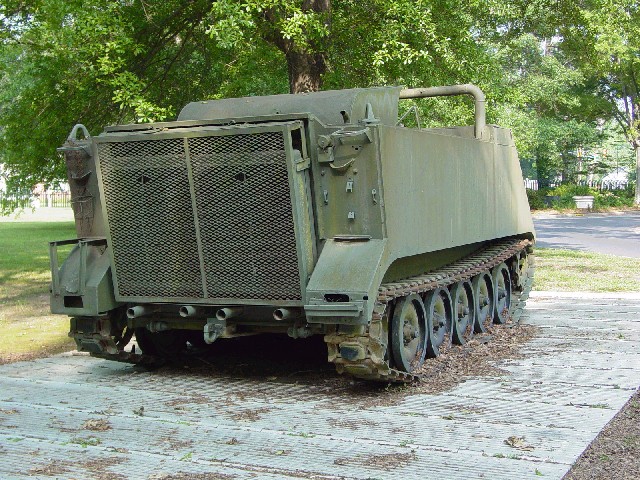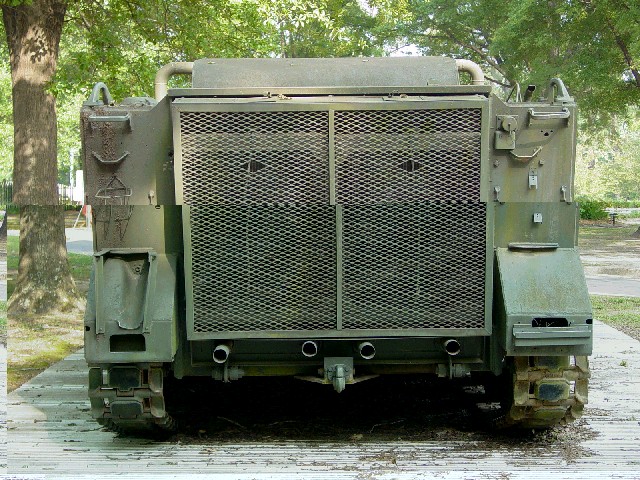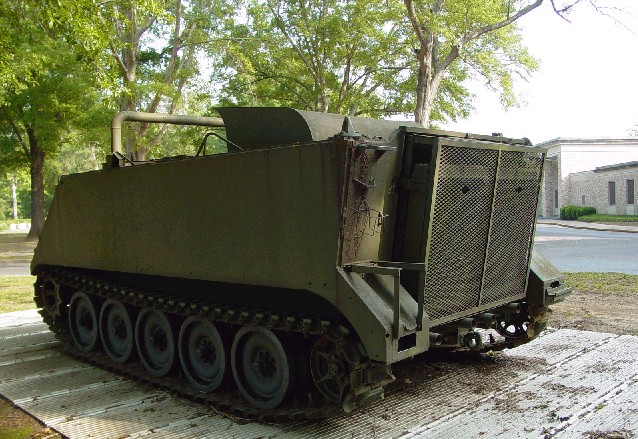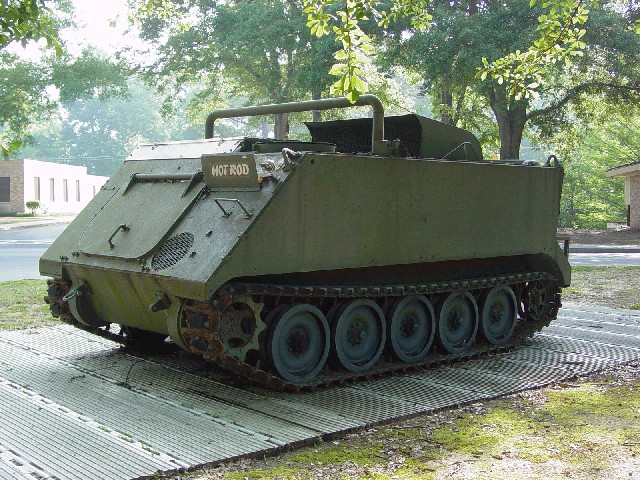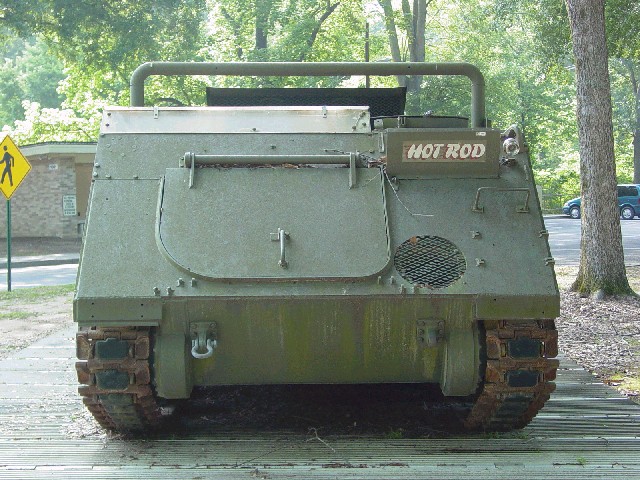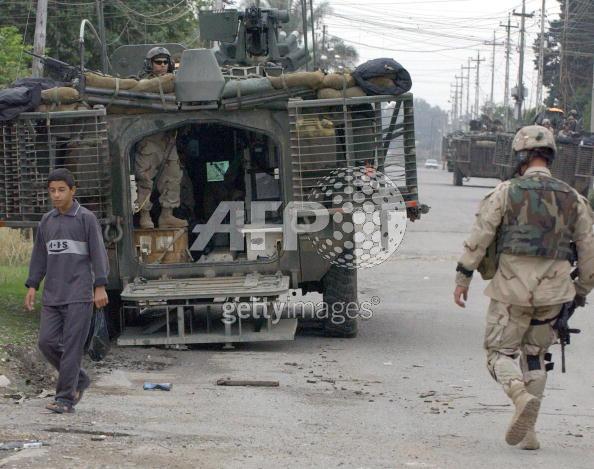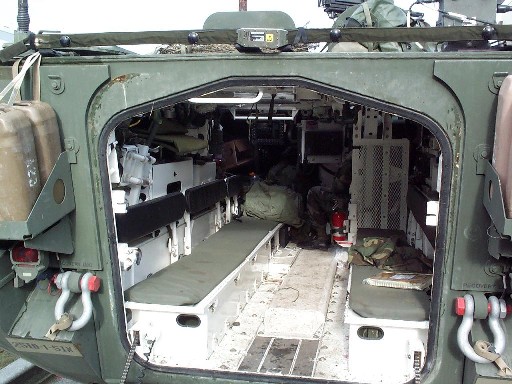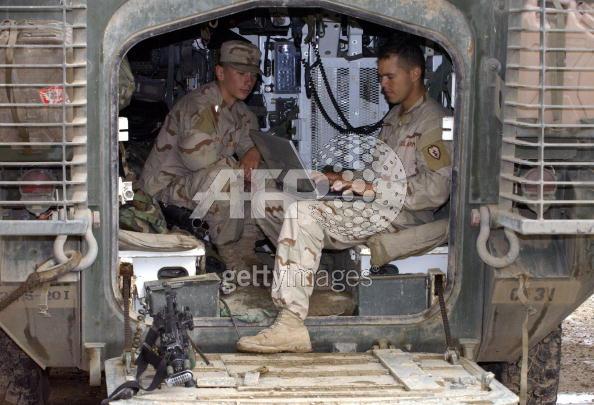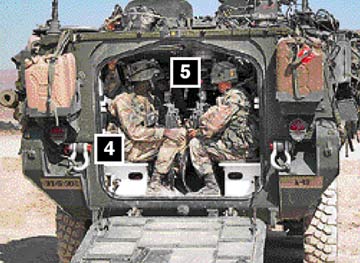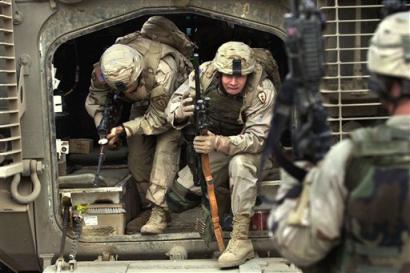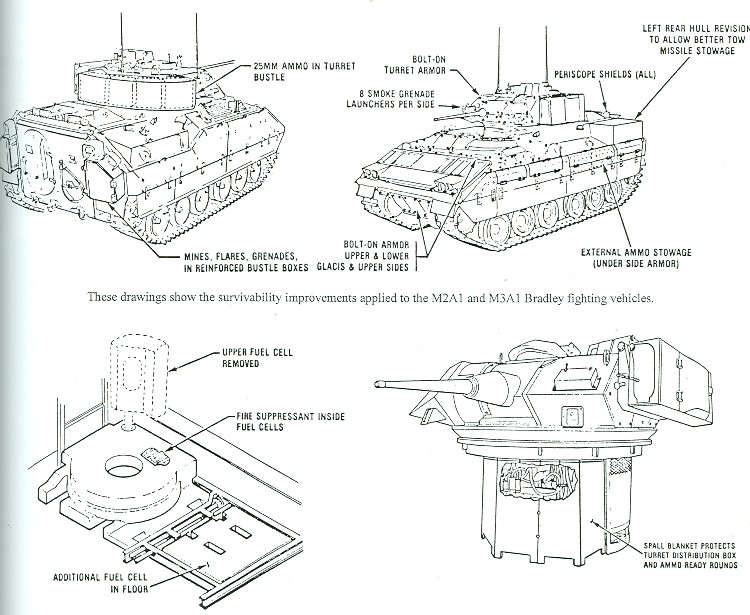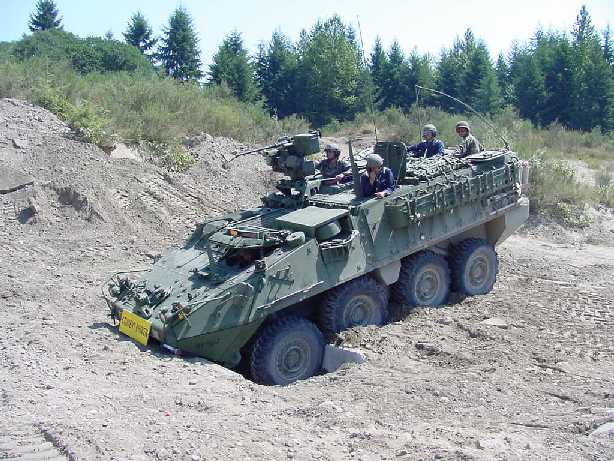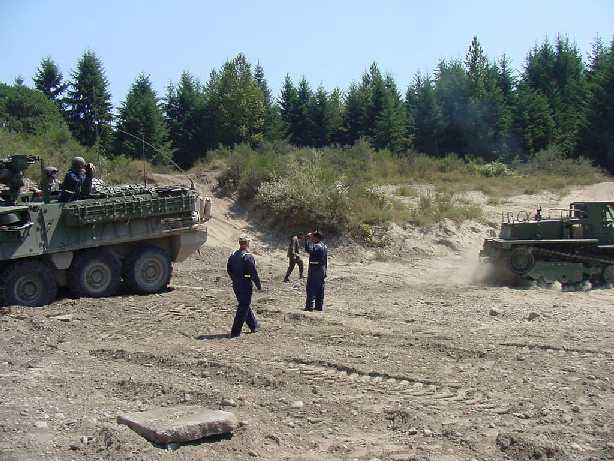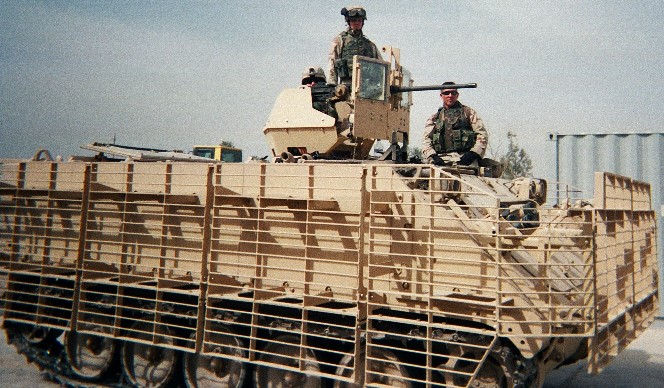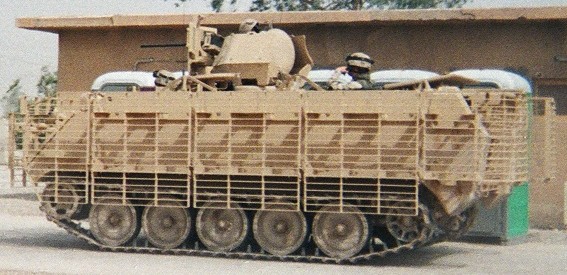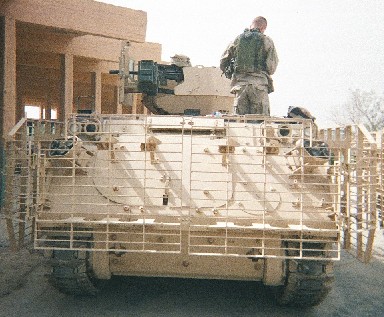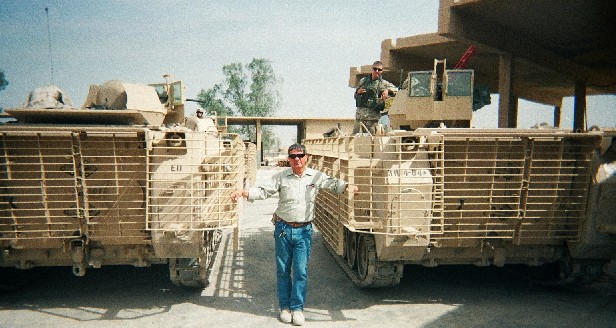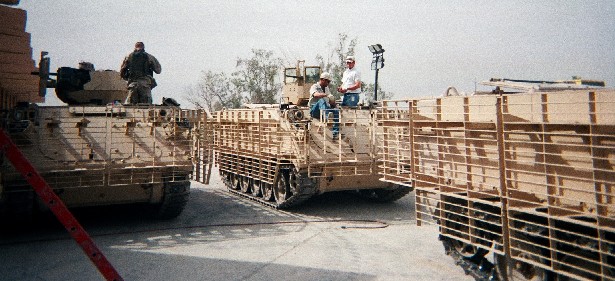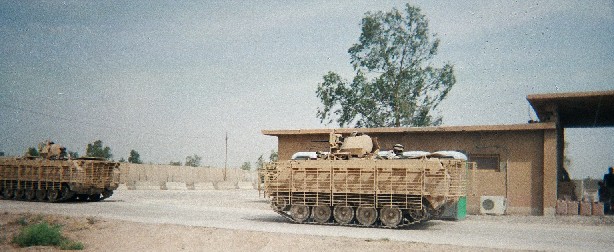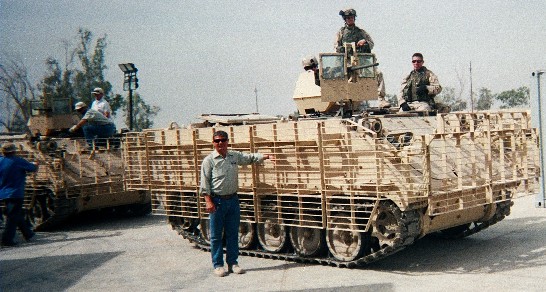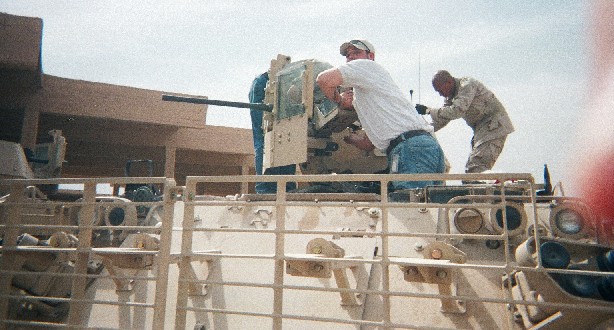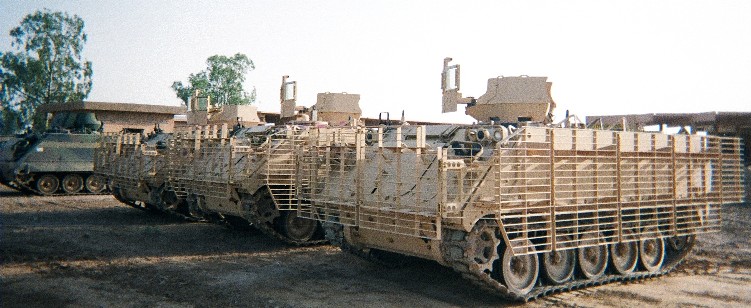UPDATED 10/20/09
The struggle to make Infantry Carrier "tanks"
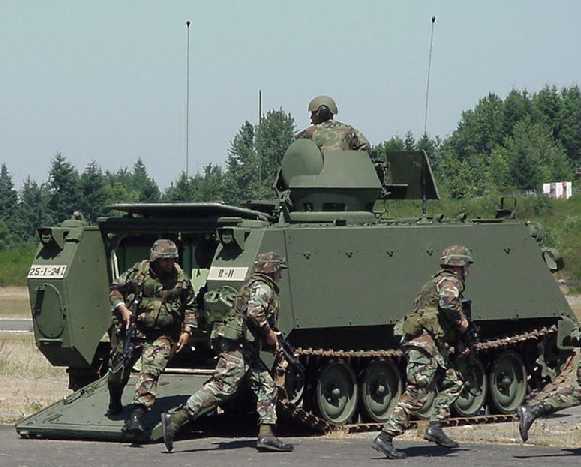
"Concern for man and his fate must always form the chief interest of all technical endeavors. Never forget this in the midst of your diagrams and equations."
--Albert Einstein
BREAKING NEWS!
Plain old "Gavin" M113 is ranked #1 by Top 10 IFV show
 http://uk.youtube.com/watch?v=CdOO1fCAOBE
http://uk.youtube.com/watch?v=CdOO1fCAOBE
Lessons of WW2 & Korea Ignored By Current Generation of Military Incompetents
The failure to understand the battle against the earth (TBATE) loses wars; in 1940 the Allies ASS U MEd the Ardennes forest was not passable by German light tanks and had no Maginot line forts there. The Germans poured through and France fell within weeks and the British were forced from the continent.
Germany panzers primarily in excellent Czech-built T35/T38 Light Tanks Swarm through Ardennes Forests Allies Thought were "No-GO" terrain
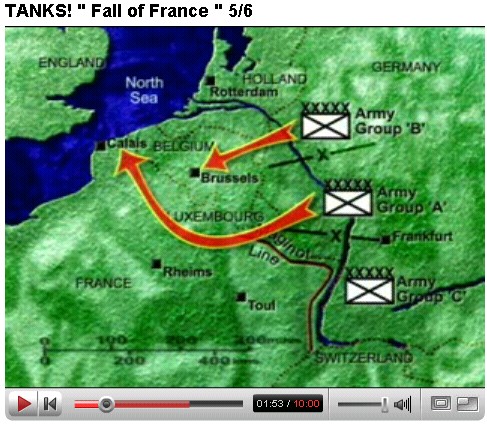
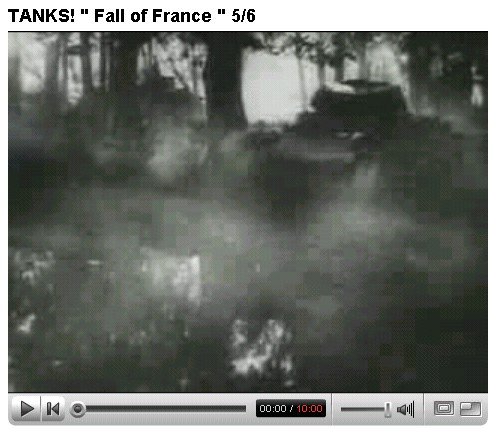
 www.youtube.com/watch?v=g4MD3-fzglM
www.youtube.com/watch?v=g4MD3-fzglM
PART 2: light tanks gobble up Poland, Stukas help with CAS, France, Germans concentrate all their light tanks in 200 mile frontage to bust through Ardennes forests, main battle tank BS, still LIGHT tanks, Panzer IV are infantry fire support role, leadership on the scene to exploit fast-moving situations, attack a village: commanders able to decide how/when to do it, GFAC liaison officer radios to Stuka pilots where to attack,
 www.youtube.com/watch?v=f91FXyUPk1I
www.youtube.com/watch?v=f91FXyUPk1I
Yet a year later, the Germans not yet fully tracked mechanized and with many wheeled trucks and no Airborne 3D to act as cavalry ahead of the main body falls short of Moscow due to severe winter mud and snow---and Russian bypassed troops and inserted paratrooper and light tank resistance.
Partially-Mechanized German Army on wheels and horses defeated by TBATE
 www.youtube.com/watch?v=CC_B8hvWPIA&sdig=1
www.youtube.com/watch?v=CC_B8hvWPIA&sdig=1
The irony is that today, TBATE is ignored by the techno-narcissist U.S. military with increasing regularity as it emasculates itself into wheeled trucks under the delusion that mental help by mouse-click will solve physical problems in the mud.
In the past, wise adult military professionals knew that light tracked, low-ground pressure mobility was vital and the British Bren gun carrier reflected this competence--they just couldn't get a roof over their heads with steel construction and remain light enough to be closed terrain, cross-country mobile as well as be transported by aircraft and gliders.
Open-Top APCs: Keep your heads, down!, Tommy!
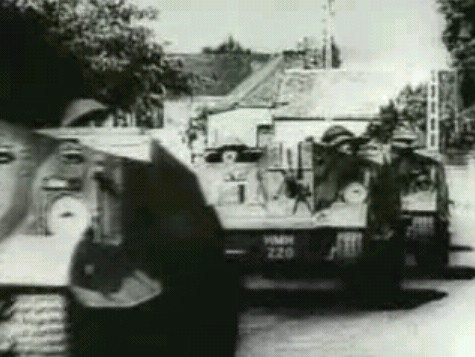
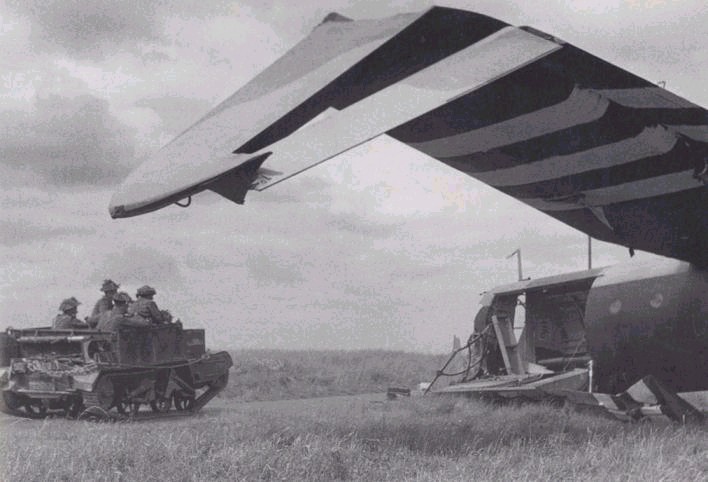
Before the 1960s we simply could not make a tracked armored fighting vehicle (TAFV) fully enclosed with the volume to carry a 9-man infantry squad out of steel to protect anything beyond bullets and have it weigh less than a medium tank (20+ tons) for terrain agility. The first German tank of WW1, the A7V was a bloated monster that had room inside to carry infantry but was found to be a high silhouette easy target to hit. British Mark I tanks were no quite as large but could carry a handful of infantry inside, too. To keep enemy projectiles out the size of tanks shrank and internal volume was lessened to pay for the weight of increased armor hull thickness. However note the DESIRABILITY of having infantry armor mobile and that these TANKS for the most DID NOT HAVE TURRETS. Anything that is ARMORED and TRACKED is a TANK notwithstanding the misguided delusions of today's heavy tanktards.
The earliest option to get infantry mobile with tanks compacted and lacking internal troop-carrying volume was to have infantry ride on top of existing compact tanks
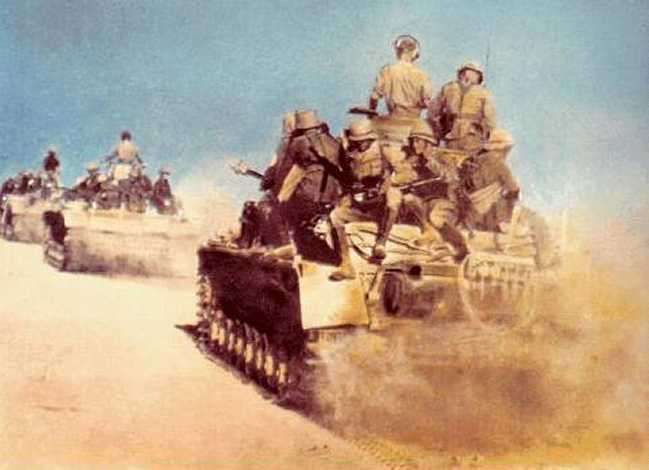
Of course, we can still have infantry ride on top of tanks today, but they are even more exposed to enemy fires and have to dismount quickly as soon as battle begins possibly long before we wanted them to start their on-foot fire & maneuver. The Russians in recent combat to expel the Georgians from South Ossetia chose to ride on top of their light tanks.
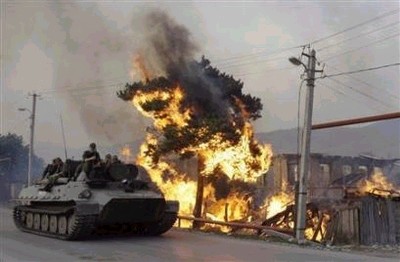
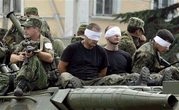
Infantry as a branch of the military--often with the weakest egos--has not been eager to create armored personnel carriers in peacetime when realities of bullets and high explosives cannot interfere with their fantasies of dismounted foot glories. This fear of mechanization as a horror unto itself can be seen in the "Terminator" movie series as well as the German drawing below from WW1. The Germans with all their dismounted stormtrooper infiltration tactics were even more impressed with the combined-arms, mechanized warfare might that came together to beat them at the end of WW1.
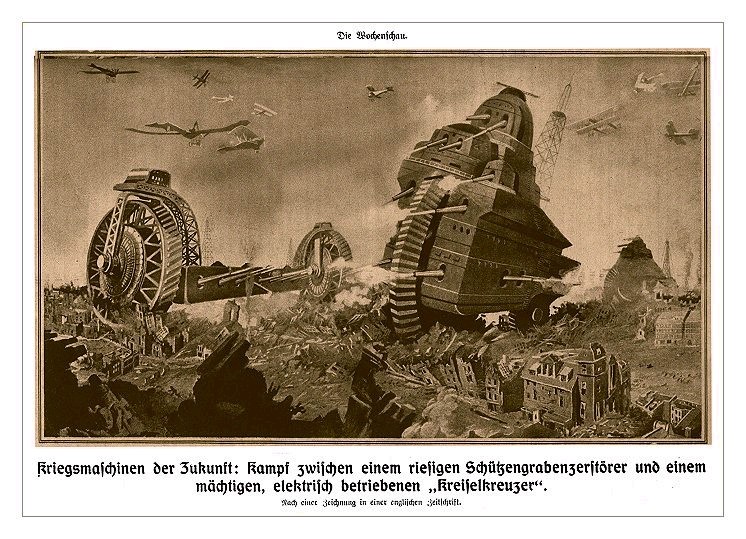
The technical problem of creating enough volume inside a tank to carry an infantry squad while having its hull thick enough to keep out enemy fire effects was not solved by either side in WW2 using heavy steel. The open-top half-track was the normal compromise used but it was only a little more protective than having infantry ride on top of tanks. The Germans even tried TOWING their infantry in armored sleds to work-around the lack of volume existing steel tanks suffered from.
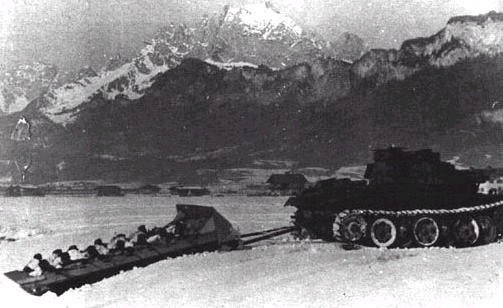
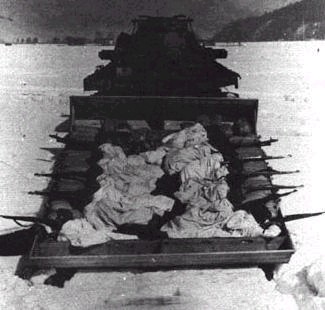
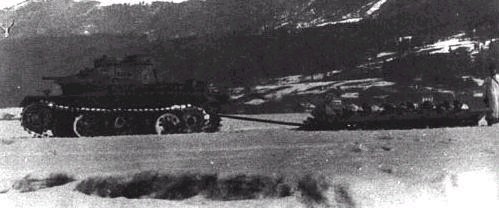
Often American infantry would walk behind our tanks, WW1-style to gain some type of protection but this resulted in a slow pace that played right into the hands of the Germans whose rear guards only wanted to delay our advance long enough for their weapons labs to produce war-winning "V" doomsday weapons. The Germans almost succeeded had it not been for men like Gavin and Patton who understood the need for decisive MANEUVER forcing us forward to over-run their labs in the nick-of-time instead of taking the plodding, WW1 walking infantry pace that conservative generals wanted to take.
Walking Infantry: A Recipe for Defeat if you Have to Get To Berlin in a Hurry
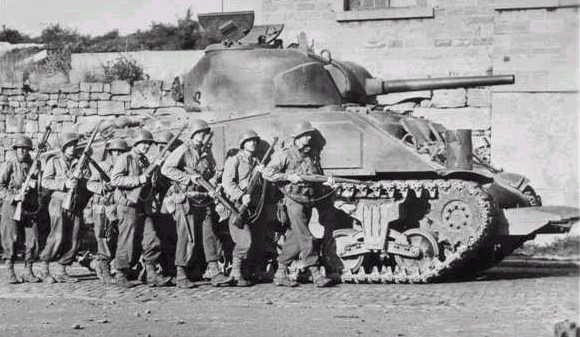
Hunnicutt's book, Bradley: A History of American Fighting and Support Vehicles reveals many dark secrets from the U.S. Army's past; problems that persists to this day.
WW2 urgency made folks try to adapt gas-powered, steel tank chassis/hulls into infantry armored personnel carriers (APCs). The M18 Hellcat tank destroyer was the fastest armored vehicle of WW2 at 60 mph on roads and made an excellent choice for an APC--but we botched it. We removed the turret and put people inside an open top called the M39. Why couldn't the troops be covered and then the covers folding down so troops could slide down them off the left/right sides to clear the tracks? Too much "fun"? Or did no one think of it? The Canadian Kangaroo APC made from a Sherman medium tank had in places the 4 inches of armor that while not stopping a German 88mm shell easily stopped bullets but was open-topped so bullets and artillery, mortar bursts could kill the Soldiers inside.
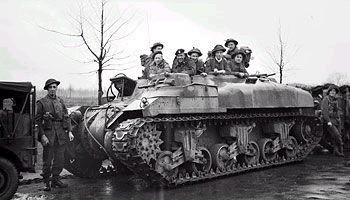
A gun tank doesn't need troop-carrying volume and can have thicker hull armor. So the idea was to start over with a larger hull that could fit troops and compromise by it being only 1/2 inch thick and accepting that it would be only bullet and explosion protective.


The M24 Chaffee light tank chassis was converted into the monstrous M44 APC, fully enclosed and could carry 27 men! It had some interesting features worth considering for today: sockets on top to accept machine guns as the situation dictated, ports for pistols to be used to shoot at enemy soldiers up close, and foot steps with a retractable chain that would be far better than attaching a step ladder as we do in our current FMTV trucks. However, WW2 ended, and the Army rejected the M44 as oversized and started over.
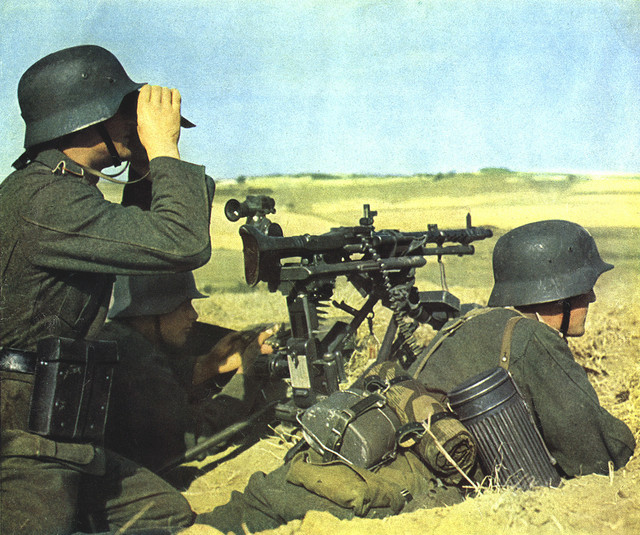
With heavy steel, if your tanks became too heavy they simply became road-bound and easily killed from the air and close-in ambushes. The Germans in a duel of tank supremacy with the Russians over the open terrain there in the eastern front came up with the Panther and Tiger heavy tanks (over 50 tons) to try to gain technical qualitative overmatch in protection against the former's T34 medium tanks only to in the west run-out-of fuel , get stuck and be swarmed by superior numbers of American/British Sherman medium tanks and fighter-bombers like the P-47 Thunderbolt and the Typhoon after being first spotted by STOL "Grasshopper" observation aircraft.
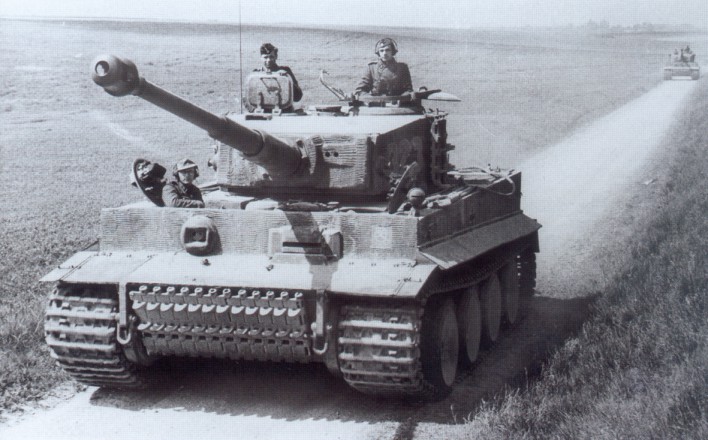
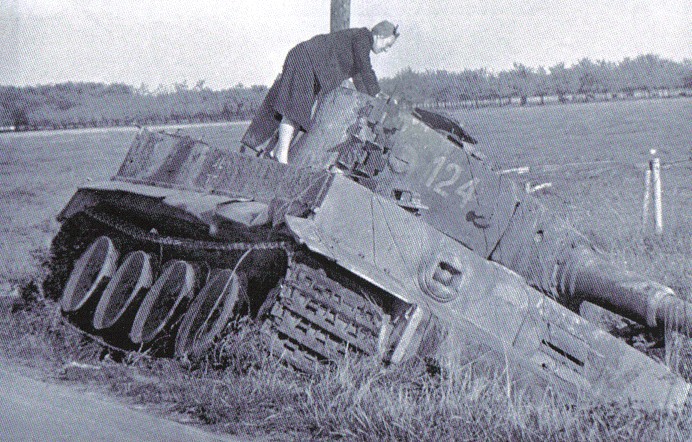
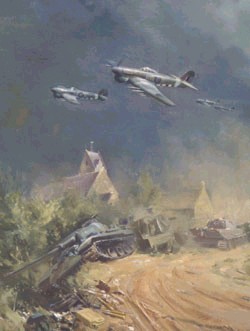
During the 1945-1950 time period our tanks were placed in museums and APC development work slowed to a snail's pace. The Army fell back on to the inexpensive WW1-style default of foot infantry with a rifle-in-the-hands and a rucksack-on-the-back. This light infantry formula had worked in the vegetated island closed terrain of the Pacific backed by tanks for fire support and amphibious assault/resupply but in open terrains in Europe/Asia tracked tanks would need to transport infantry also or else they would be exposed/killed and simply bypassed/ignored. Tanks cost money $$$ and America felt atomic bombs from aircraft would prevent us from ever having to fight on the ground so the Army demilitarized and monies poured into strategic bombers.
MacArthur's Japanese occupation army having a wonderful time chasing newly liberated Japanese women fell back onto the "From Here to Eternity" foot infantry-default thinking they could fight WW2 Pacific-style if needed but forgot that looming to the west was the Asian continental land mass where tracked tanks rule the open terrains. You will see that these garrison cultural pressures to spend less money as troops goof-off and adopt weak, foot-infantry battle techniques has manifested themselves again in the Shinseki era to do feel-good peacekeeping missions and perpetuates today with Schoomaker's "high-tech red-neck" gunslinger mentality. Its always easier to do less in the Army. The Korean War debacle that began with Task Force Smith entering battle after being flown in from Japan, at a rifle-and-rucksack default before being trounced by North Korean T34/85 medium tanks would be repeated again and again over the years.
Please take a few moments to read the account below of TF Smith and examine the map showing where they were positioned to block the road and consider the terrain where it was go and no-go for tracked and wheeled vehicles.
www.korteng.com/Appleman/Chapter6.htm
Notice TF SMITH HAD WHEELED TRUCKS.
They were parked behind their defensive positions on the road to their rear.
We doubt if even Strykerrr TOW ATGMs fired from their rubber-tired mounts would have changed the outcome as the T34/85s would have point/shot/blasted them on the road. Ditto that for MGS even if that 105mm gun variant worked.
Once surrounded and routed the foot troops would be no better able to withdraw in Strykers along roads than they were in 1950 in unarmored trucks.
Also ponder that when TF Smith flew in by C-54s they COULD HAVE HAD light tracked APCs: here is a photo showing a M22 Locust light tank underslung a C-54 transport plane which had tricycle landing gear...
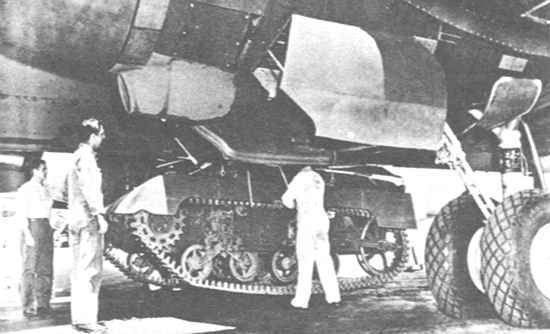
Maybe we shouldn't have been so quick to dismiss C-54s carrying light tanks, huh?
If the light infantry narcissists with WW1-style Pacific island foot-slogging fights had been on the ball instead of chasing Japanese women they would have realized their M24 Chaffee light tanks which the 24th ID had could have been flown into South Korea by new USAF C-124 Globemaster II aircraft...probably spending too much time playing "From Here to Eternity" garrison games like they do today....
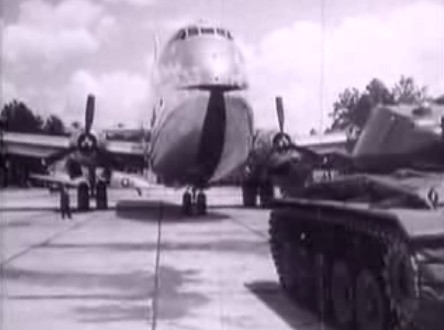
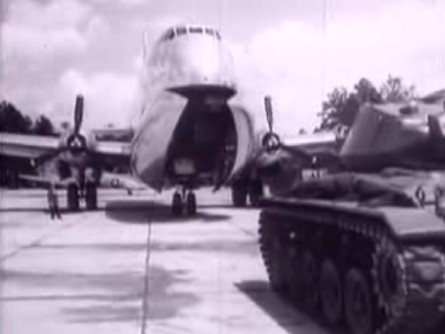
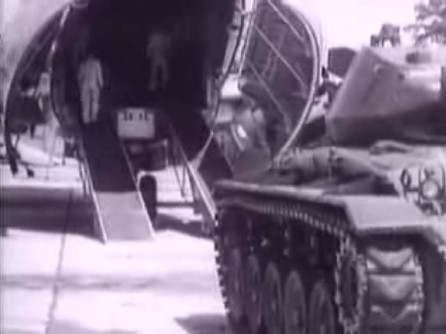
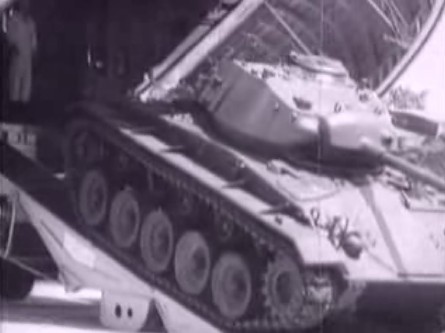
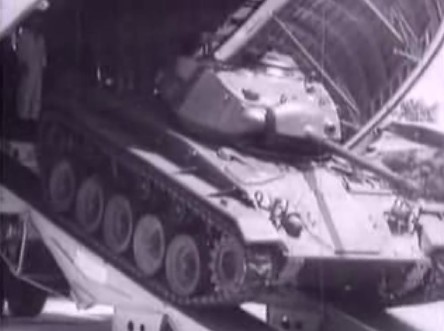
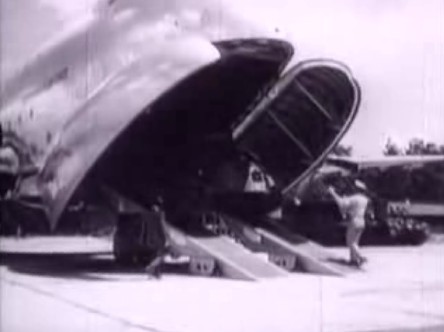
Imagine if after WW2 we didn't go back to sleep and neglect ground warfare as General Gavin fought hard to warn us not to do...M22 Locusts had been fitted with 106mm recoilless rifles and flown in by C-54s, others Bren gun style open-topped troop carriers....backed by some M24 Chaffee light tanks with some hydraulic oil bought by not going out on the town for one night for their 75mm guns....maybe we could have stopped the T34/85 medium tanks? The French were able to fly in M24s in pieces using less airlift so you can disparage the French all day, at least they used EVERYTHING they had to try to win. What's our excuse when we fail when we could have succeeded had we TRIED?At the very least we could have withdrew in good order...under some armor protection with some tracked mobility to pull out our wounded...when foot infantry is wounded it cannot walk anymore...if swarmed by enemy infantry you cannot afford to try to break out barreling down roads in rubber-tired trucks...
Only TRACKED armored personnel carriers (APCs) that could have enabled them to move cross country in the face of intense enemy fire would have helped them conduct a mobile defense and carried the heavy firepower that could have been brought to bear from unexpected locations and move themselves, their wounded and their supplies. The whole point of the Army experience after Korea was NOT to move men around in helicopters so they could afterwards get shot up. The Korean experience forced the Army to get serious about tracked APCs beginning with the M75 at war's end, followed by the M59 and finally the greatest AFV of all time, ever--the M113 at the behest of Gavin that was amphibious, air-transportable so infantry was not orphaned after airlanding and could move boldly even nuclear devastated battlefields.
The Smoking Gun: Light Tanks/APCs More Mobile than Medium-Weight Ones, and M113 Gavins were the MOST effective weapon in soft open and vegetated closed terrain terrain Vietnam--NOT the helicopter
Cross-Country Mobility for Dummies:
Noted armor historian and WW2 Hobart's "Funnies" (combat engineer tanks) combat veteran Major Kenneth Macksey wrote in his 1991 book, Tank versus Tank, page 167:
"The Vietnam War was a war dominated by infantry and firepower, in which AFVs, initially, were relegated to a limited part because the Vietnamese possessed virtually no tanks of their own and their enemies persisted in thinking of the struggle as a guerrilla war in country unsuitable to tanks. Not until 1967, when the United States carried out a feasibility study, was it discovered that tanks could move in 61 per cent of the country during the dry season and in 46 per cent in the wet; and that APCs could move in 65 per cent of Vietnam all year round. Thereafter the forces of South Vietnam rapidly raised their armor content to be matched only meagerly, however, by their opponents. As a result, AFVs were almost entirely employed in support of infantry; the principal threat to them was posed by mines and infantry anti-tank weapons, including ATGW. Yet AFVs were rated the most cost-effective weapon system for a country where the helicopter was enjoying a great vogue on the battlefield."
What this means is as follows:
M113 Gavins (light tank/APCs) 8 PSI ground pressure = 65% of Vietnam dry/wet 24/7/365
M48 Pattons (medium tanks) 11.2-12.2 PSI * ground pressure = 46% of Vietnam wet season
.............................................................................................................61% of Vietnam dry season
The Best Tank for Closed Terrain COIN: the Light, Amphibious, Air-Mobile M113 Gavin
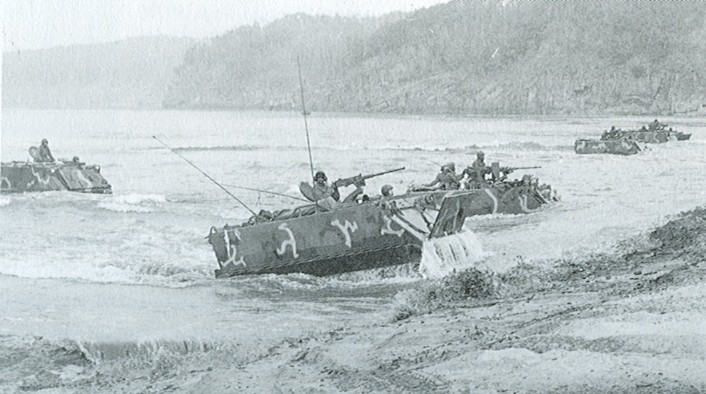
Central High Lands Jungles
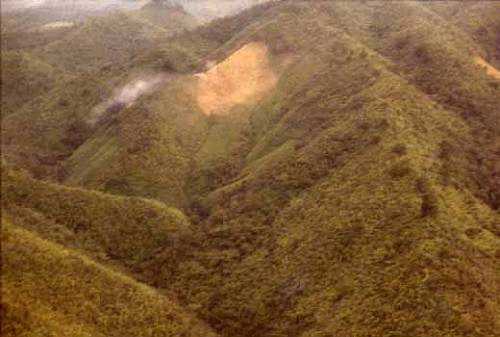
Southern Plains and Soft Marshlands
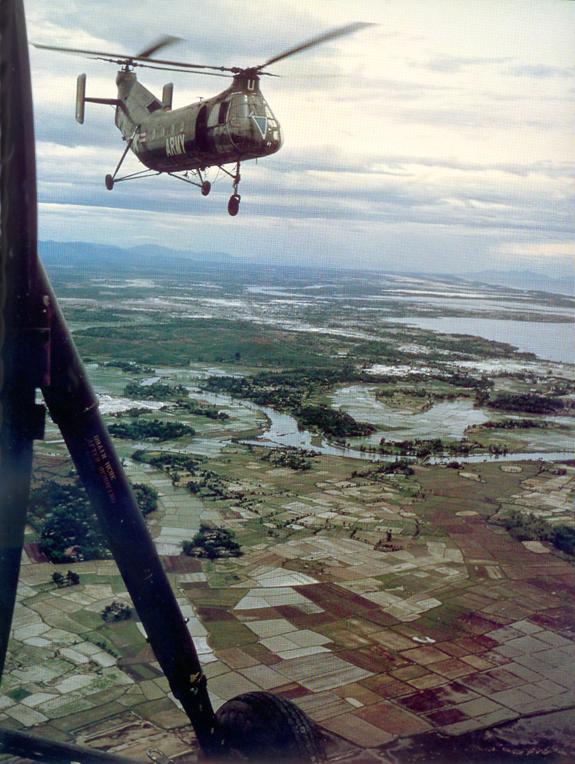
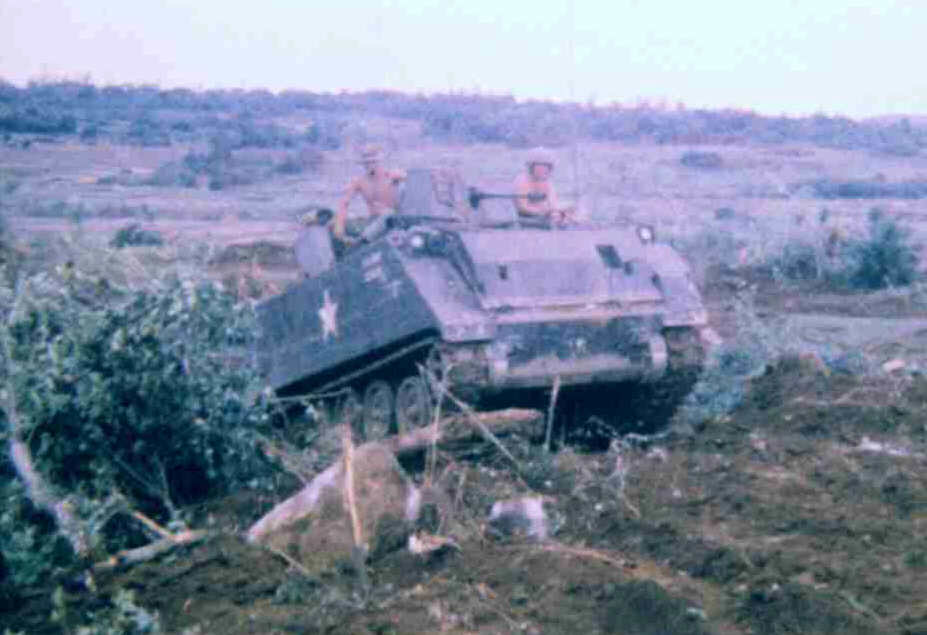
Regardless of where you were in Vietnam, THE MOST MOBILE VEHICLE WE HAD THERE WAS THE M113 GAVIN LIGHT TRACKED TANK. Smart armies knowing difficult terrains require cavalries operating in front of their main bodies use LIGHT TANKS, not heavy ones and certainly not ANY wheeled trucks that require man-made strips of OPEN TERRAIN called roads/trails that invite enemy ambush!
Wheeled Trucks Ask for Ambush & Destruction
Vietnam
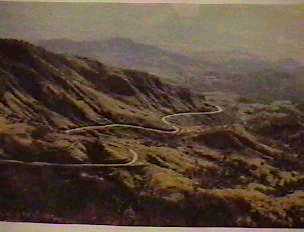
Korea
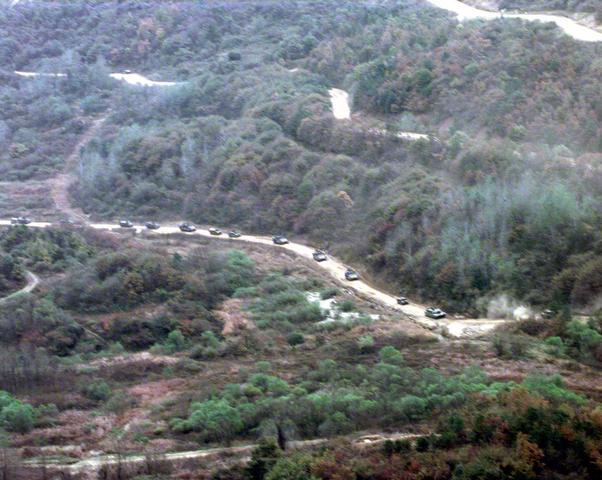
Afghanistan
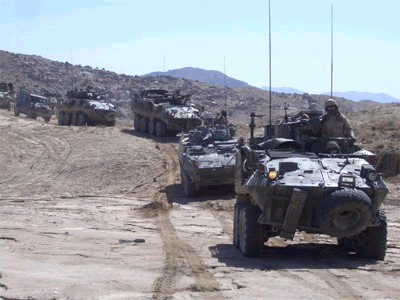
Iraq
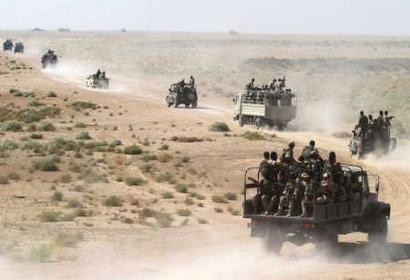
The U.S. Army rejected multiple-wheeled APCs in the 1950s after learning their experiences from WW2/Korea!
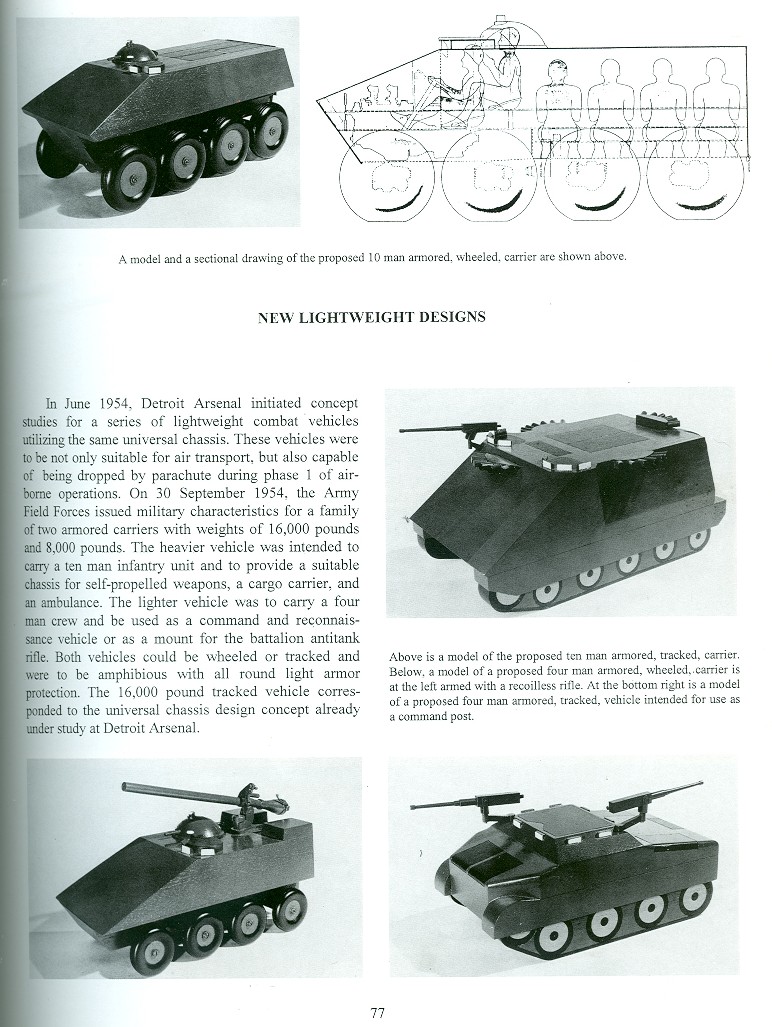
This is why the M113 was built by LTG Gavin and so highly successful shortly afterwards in Vietnam-and all over the world!
http://stinet.dtic.mil/oai/oai?verb=g...
Accession Number : AD0351252
Title : MECHANIZED RIFLE TROOP (M-113)
Corporate Author : ARMY CONCEPT TEAM IN VIETNAM APO SAN FRANCISCO 96384
Personal Author(s) : Godwin, Norman A. ; Scheumann, Marcus C.
Report Date : 25 JUN 1964
Pagination or Media Count : 1
Abstract : Organization, operations, and vehicle performance of M-113 armored personnel carrier-equipment mechanized rifle troops of the Army of the Republic of Vietnam (ARVN) were evaluated during counterinsurgency operations from 1 February 1963 to 31 March 1964 in the Republic of Vietnam. Troops were observed as they engaged in training, maintenance, and combat operations in each of the four corps tactical zones of South Vietnam. It was found that the ARVN mechanized rifle troop, with the exception of the support platoon, was well-organized and equipped for counterinsurgency operations. The evaluation revealed that the M-113 armored personnel carrier (APC) can fulfill the assault vehicle or tank role in counterinsurgency operations such as those conducted in the Republic of Vietnam when the insurgents have no armor and limited antiarmor capability. Optimum tactics and techniques for mechanized rifle troops were not determined. However, these units were most successful when employed offensively. The ARVN mechanized rifle troops can successfully perform amphibious operations in light surf, and can negotiate inundated areas in the RVN. A self-recovery means and other expedients are required for the M-113 when operating in terrain such as found in the delta region of Vietnam. The APC operated best in the relatively open, inundated areas of the delta and coastal lowlands. (Author)
Descriptors : *COUNTERINSURGENCY, *PASSENGER VEHICLES, VIETNAM, VIETNAM, ARMORED VEHICLES, MILITARY FORCES(FOREIGN), FEASIBILITY STUDIES, TERRAIN.
Subject Categories : UNCONVENTIONAL WARFARE
Distribution Statement : APPROVED FOR PUBLIC RELEASE
 www.youtube.com/watch?v=UiQ5kmoumQ4
www.youtube.com/watch?v=UiQ5kmoumQ4
A light mechanized infantry with M113 Gavin light tank/APCs would fight mounted and/or with these vehicles nearby rendering fire support and ammunition, water, food transport 65% of everywhere to include swimming across lakes/rivers; only 35% of the terrain was dismounted foot-travel only--we fight the enemy from positions of overmatching SUPERIORITY with more firepower and units of fire, as well protection from his fires.
If we medium-mechanize or motorize with high ground pressure FCS 30-ton tanks (12 PSI) or 20-ton Stryker truck (30 PSI) wheels 54% of a soft, wet terrain like Vietnam will be NO-GO to them and be enclaves for the ENEMY to reside in safety lest we fight them M16 vs. AK47 & RPG even or at a disadvantage. The enemy could attack us during the wet winters and withdraw without fear of us pursuing them lest we get stuck or stick to roads where they ambush us with land mines. The FCS will only be mobile in firm, open terrain types, and the Stryker, road-bound unless very firm, dry, open terrain is available. Neither FCS or Strykers can swim.
Sub-Notes
* http://afvdb.50megs.com/usa/m48patton.html
M113 Gavins Kick-Ass in Vietnam-and all over the world!
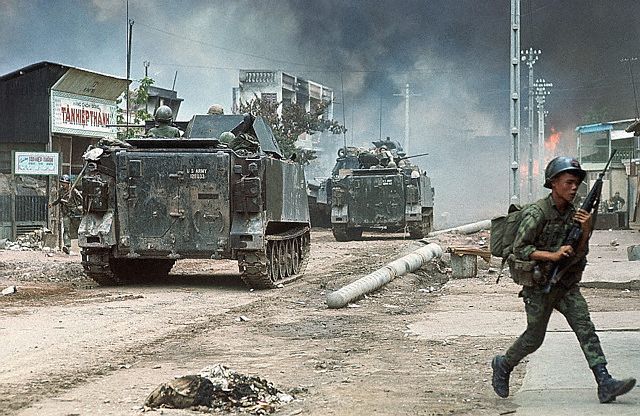
We progressed with M113s with gunshields to fight mounted with the ACAVs, and had firing ports figured out with a shoot-on-the-move autocannon with the AIFV when we went overboard with the 2-man turret Bradley to escort heavy M1 Abrams tanks. Infantry became second-class citizens and security guards for tanks (armored infantry) when we should have simply kept improving our M113 Gavins so ALL our infantry would have armored mobility even those that come by aircraft (Army's 4 divisions of light infantry).
What has happed since this time is nothing less than tragic.
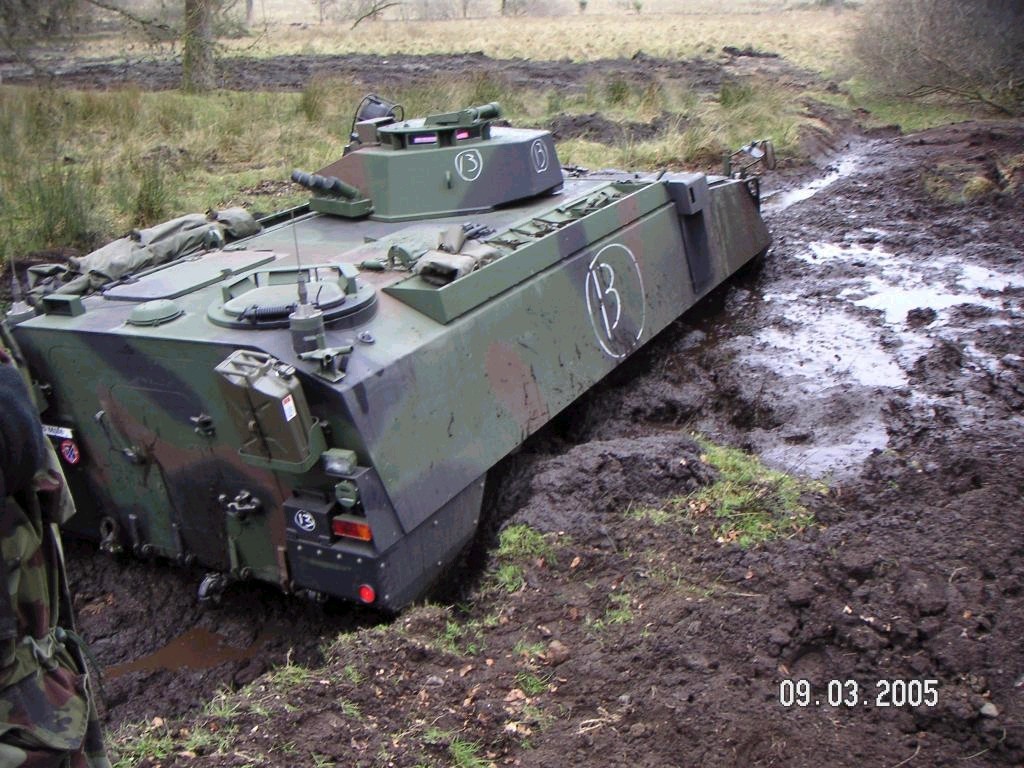
Instead in 1999, the infantry led by a CSA who wanted a cash cow from Congress revolted with a regression into Soviet-style wheeled BTR motorized infantry when the problem was an oversized turret on the Bradley cooping the infantry up in back, not tracks. At great expense, we have bought a handful of thin metal boxes without turrets on 8 air-filled rubber tires dubbed "Strykers". We have once again reverted back to the feel-good, narcissistic foot-infantry-in-trucks pre-Korean war default mode this time institutionalized with the Canadian-made, expensive Stryker trucks begging for a high-tech version of the TF Smith debacle.
Yet Another Stryker Truck...Stuck...
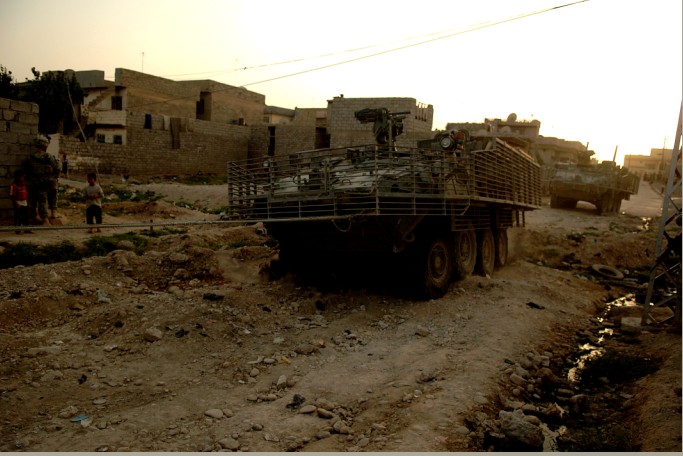
Planet earth itself has not significantly changed and the battlefield has gotten MORE not less lethal, making tracked AFVs even more critical. The best Army vehicular example of the Stryker truck silliness that we can somehow pick/choose a narrow set of situations to use the Stryker infantry is the WW2 M3 White scout car and tank destroyer debacles. Mechanized cavalry doctrine tried to have troops sneak ahead to observe the enemy and report back in unarmored, rubber tired cars. The German enemy in North Africa lefts hundreds of burning American vehicle hulks via artillery and mortar fires not factored into our pre-war force designs and war games. Lou Dimarco's excellent mechanized cavalry doctrine brilliantly details this: www.loudimarco.com
The tank destroyers had the 90mm guns needed to kill German tanks but our own tanks were denied them (its not your job to kill tanks!) and Sherman tank losses were horrific when the TDs could not and were not where they needed to be on the fluid mobile battlefields of Europe. Dave Johnson's Fast Tanks and Heavy Bombers and Belton Cooper's Death Traps detail the Sherman medium infantry exploitation-through-enemy-lines tank disaster.
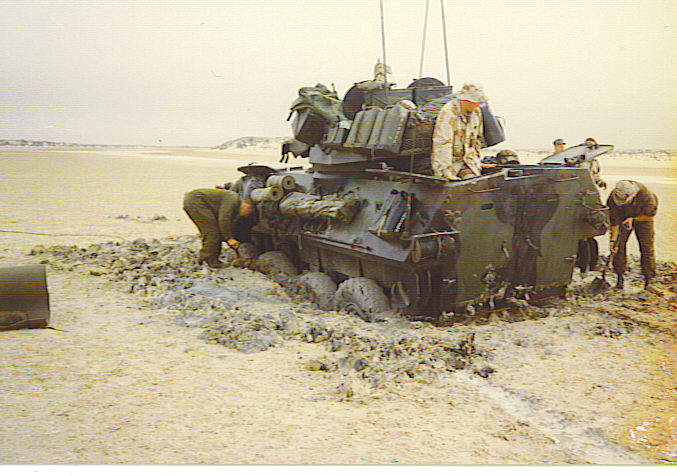
LAV-3/Strykerrs fail in Afghanistan; Canadians ditch their own wheeled trucks for more mobile and better armored tracks! Enter Leopards and M113 MTVL Gavins!
The Dutch are using M113 Gavin tracks, too and are being VERY successful in counter-insurgency operations!
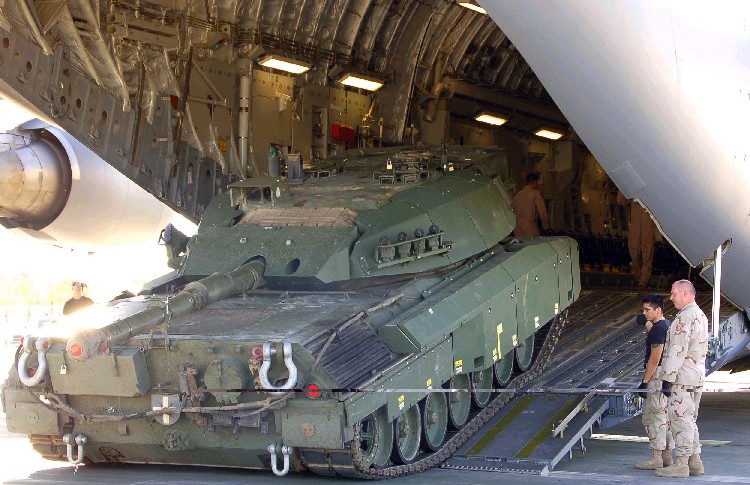
 www.youtube.com/watch?v=GrATZkFUhaI
www.youtube.com/watch?v=GrATZkFUhaI
 www.youtube.com/watch?v=ZKa3tK3zi4c
www.youtube.com/watch?v=ZKa3tK3zi4c
What caused the turn-around?
COMBAT.
REALITY.
AFGHANISTAN.
A DESIRE TO WIN, NOT CONTINUE TO LOSE IN WHEELED TRUCKS...
EXPERIENCE ONE FAILURE DAY IN THE LIFE OF A FUBAR LAV-III/Strykerrr UNIT....
Strykers fail: VIDEO of Canadian LAV-IIIs hopelessly stuck in mud, breaks main bearing, mission aborted
American Stryker versions of the LAV-III are even more bloated and weighted down with bird cage and electronics inside....why are we wasting $4M on each of these flat-bottom, road-bound trucks?
From the recent PBS documentary, "Afghanistan: the Other War"
Go to 2:58 and see why the Canadians have gone to tracks in Afghanistan like other smart armies, Brits, Dutch etc.
Canadian LAV-IIIs hopelessly stuck in mud, breaks main bearing, mission aborted
 www.youtube.com/watch?v=SXFMix3dudU
www.youtube.com/watch?v=SXFMix3dudU
We need to stop wasting billions on fatally flawed break-down-prone wheeled Strykerrr trucks that fail to get the job done and put our men into constant road/trail ambushes and put our money into M113 Gavin light for cross-country mobility but medium-weight in armor protection tracks that don't get stuck and break down in a mere light rain and minor mud.
STILL PHOTOS OF THE LAV-III DEBACLE IN AFGHANISTAN (AMERICANS EXPERIENCE THIS DAILY, TOO)
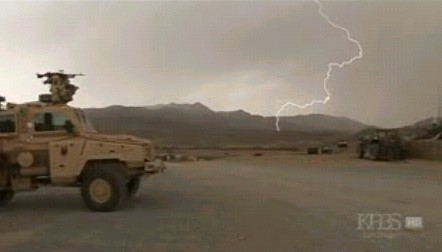
2: "We are going to make contact with a new village and reach out to them and win over their hearts and minds in our low-maintenance, all-terrain, high-speed SASO wheeled vehicles. Our LAV-IIIs are used by the Americans who call them 'Strykers'".
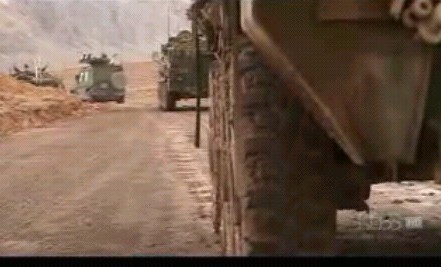
3: "WAHOO! Look at Me! I'm going 60 miles per hour on the road!!" (Not for long!)
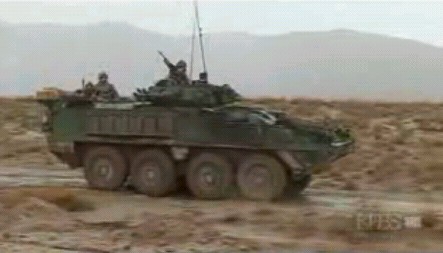
LAV-III stuck a 1st time; Road Speed: 0 MPH
4: "Ohhh....sh$%^&! I drove into a rut....."
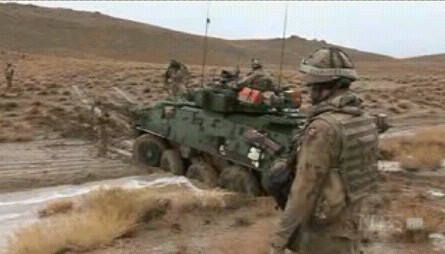
5: "Can we get it out?"
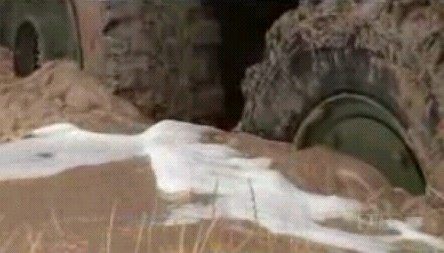
6: "We had technical difficulties and had to cancel the mission to the village"
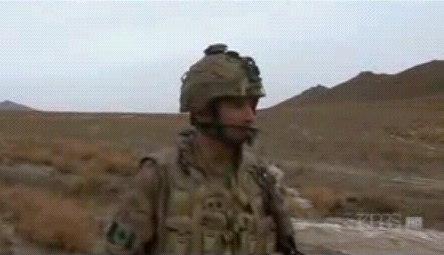
7: "What's that dangling underneath the LAV-III?"
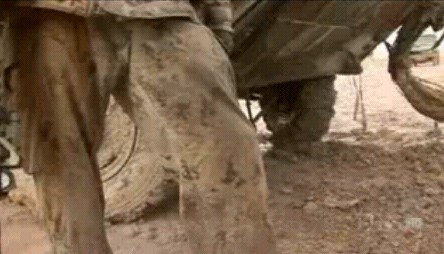
8: "Oh No. Its the main bearing. Its broke, man. This thing won't run its trashed."
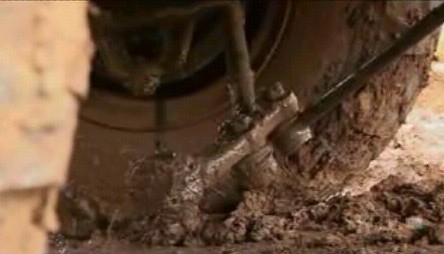
9: "What a Piece-of-Shit (POS)."
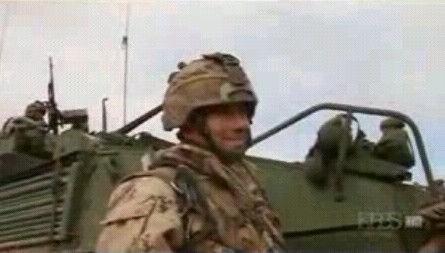
10: "Careful! Don't get the 'recovery' LAV-III stuck, too!"
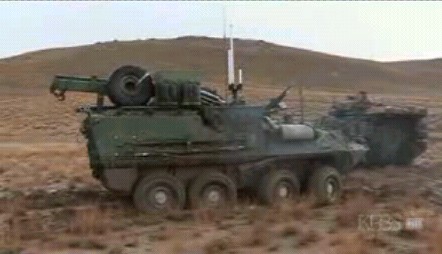
11: "Oh Boy. The 'recovery' LAV-III is spinning in the mud, too."
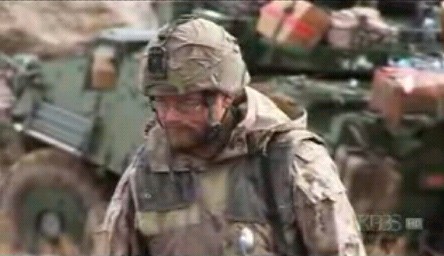
12: "Please...please grip...grip....we don't want to be stuck here outside the wire when the sun goes down..."
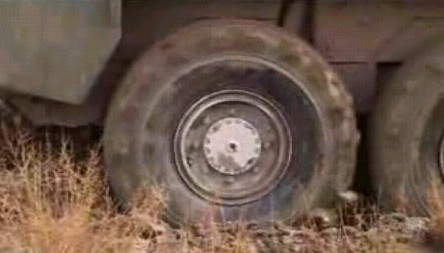
LAV-III stuck a 2d time
13: "Gun it!!! Get through the dip!"
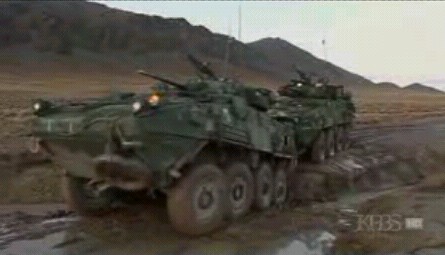
14: "Damn! We are Stuck Again! Dude! It's Getting Dark!"
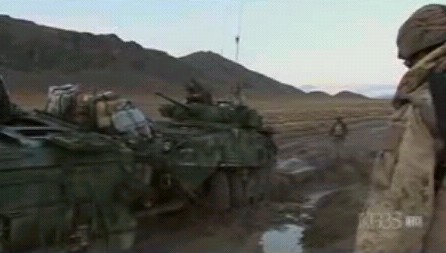
15: "We Got to get Back to the FOB before the Taliban come out!"
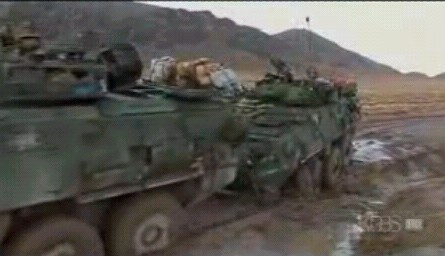
16: "Go Easy! Easy! Let the Wheels Catch!"
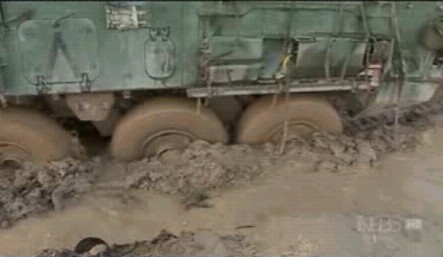
17: "Damn. Forget it. Cut the Engine!"
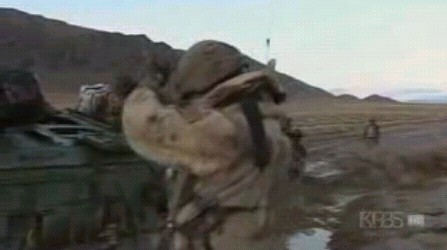
18: "Mission Aborted! Maybe an officer will figure this out."
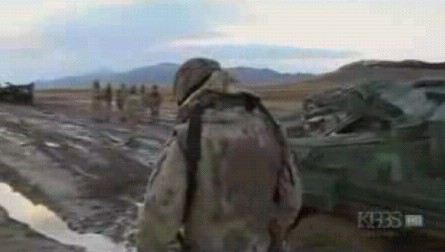
"We REALLY showed our Afghan allies today why they should trust their very lives to us.
Yeah, Right. We need to turn these pieces-of-shit in and get tracks so we can win"
Paul Hornback's Wheels vs. Tracks Article in the March-April 1998 issue of U.S. Army Armor magazine (before it became politicized) Warned Us Against the Wheeled SASO "Nation-Building" Racket EuroFad
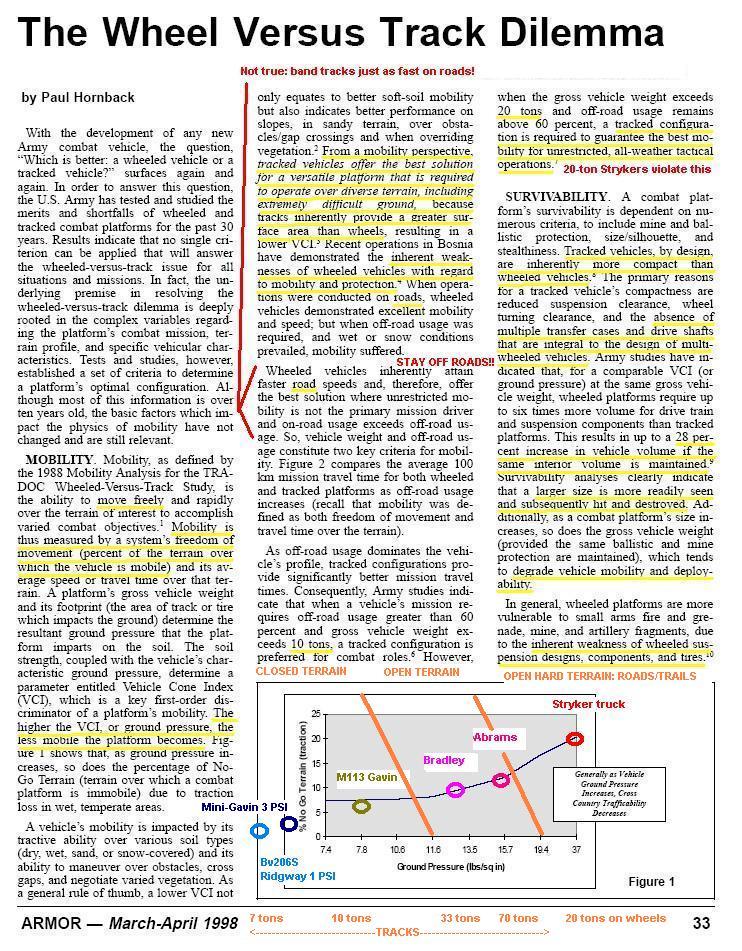
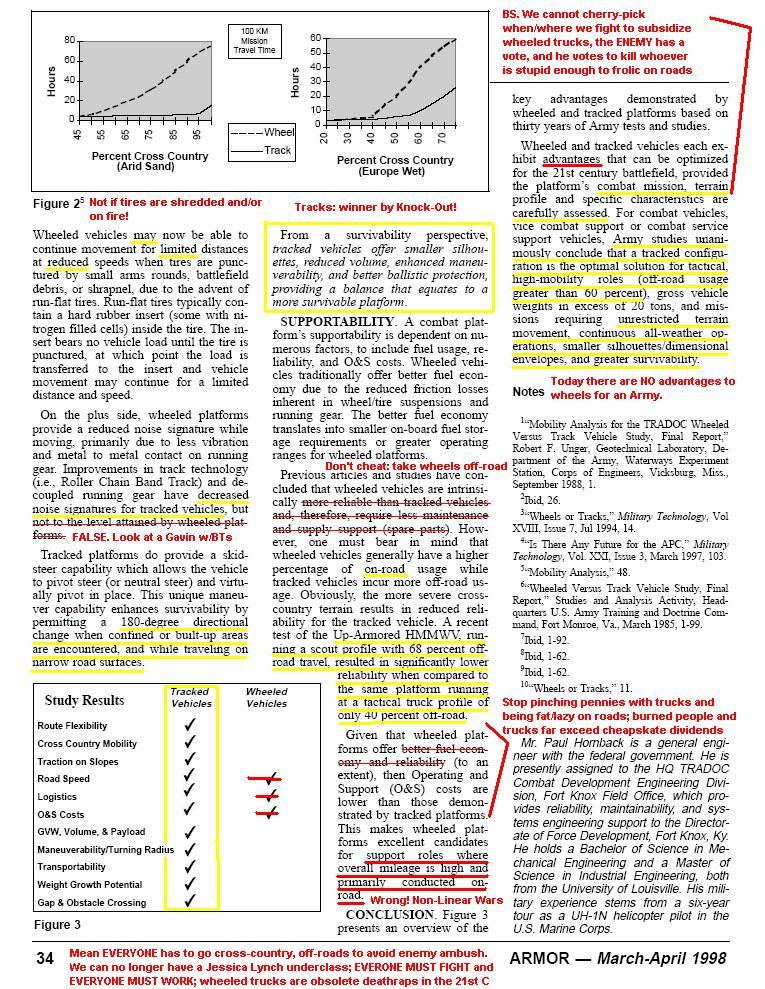
Steel Tracked M113 Gavin went 75+ mph in 1979! There's NO justification for wheeled trucks on the non-linear battlefield!
According to Hunnicutt Bradley: A History of American Fighting and Support Vehicles on page 109, the "Hot Rod" averaged 75.76 mph over a 500 foot gravel test track at Fort Knox in 1979. Power was 2 x 440 cubic inch Chrysler gas engines driving two modified 727 transmissions.
Imagine what M113 Gavins would do today on band tracks with hybrid-electric drive!
www.combatreform.org/bandtracks.htm
www.combatreform.org/hybridelectricdrive.htm
...thanks be to retired LTC Dave Tooker for finding these pictures!!
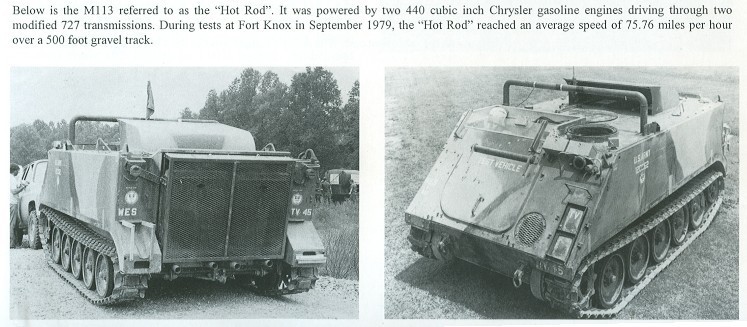
We have known for years that plopping a thin but heavy metal box on top of rubber tires does not result in an all-terrain mobile vehicle. The USMC if consulted in-house and not tapping into their external braggadocio would tell you their LAV-1s are miserable failures in all factors, mobility, armor protection and without a 25mm gun turret, firepower. Shinseki didn't ask, and the marines didn't tell. Now both are FUBAR.
And neither will the LAV-III/Stryker's myriad of variants---the Stryker truck is also born of phony Army war games, this time high-tech at the Fort Irwin, California National Training Center (NTC) that do not accurately factor in mortar/artillery fire shredding and igniting rubber tires. Wheeled vehicles do not even have MILES laser tag receptors for simulated bullets to deflate them--we live in a fantasy world like the 1930s where rubber tired trucks get a free ride on the firm-soil southern California desert because we want them.
Knuckling under to ecologist pressures to not leave/roads and trails on restricted and cluttered with civilian buildings Army posts where our Soldiers spend most of their time, the Stryker/Humvee truck mentality "stays in its lane" so everything stays tidy. And do not even think about SWIMMING vehicles; this is dangerous and the Stryker/Humvee trucks can't swim anyway. M113 Gavins can swim but who says our Army wants to get ready now for wars that are not tidy where the unexpected path and bold maneuver across lakes and rivers surprise enemies and avoid roadside bombs? The real enemy here is the ITAM eco-nazi who will have your head and your career if you run over a tree with your track.
Some Stryker truck spokesmen have tried to dishonestly justify Strykers as progress because its either "Wheels or Walk". To those in the stone age of military mobility (they were lightfighter who walked previously), the "wheel" looks like "science fiction".
These Stryker proponents are dangerously wrong---its Aircraft, Tracks, Wheels or Walk?---and many combinations thereof. If we do this right we use tracks that can fly by aircraft, swim and go-cross country even in the face of enemy fires. Anything less and we put ourselves at risk of suffering another Task Force Smith.
The memories of TF Smith prompted former Army Chief of Staff, General Gordon Sullivan to constantly proclaim "No more Task Force Smiths" yet his hand-picked replacement, General Dennis Reimer retired our M551 Sheridan light tanks and refused to buy the M8 Buford Armored Gun System light tanks the 82nd Airborne and 2nd ACR needed so they would not be flown into TF Smith situations without light TAFV firepower and at least hitch-a-ride-on-back mobility beyond a foot slog.
Enter the SASO "Boots-on-the-Ground" Racket
The Balkans belligerent didn't engage in landmine against the U.S. because both sides knew to lay low and milk us economically.
However, as the Army/Mc were doing their nation-building SASO/COIN racket during the '90s to soak money from "peace dividend" Congress if they had spent less time doing PT and looking at themselves in the mirror they would have been in the library reading Jane's and learned Hezbollah is southern Lebanon were making very large land mines to blow up the very heavy medium to heavy flat and thin-bottomed Israeli tanks that were riding along roads for crew comfort.
We need to realize that GOING CROSS-COUNTRY requires MORE WORK and is LESS COMFORTABLE than going along the roads/trails. Medium-to-heavy tracks require more maintenance and trailers to move them around etc. than wheels
Operating medium-to-heavy tracked tanks COST MORE than operating wheeled trucks which means MORE MONEY FOR THE MILITARY BRASS to go fuck off and build their empires to self---buildings that require lawn and floor care from the underclass with less rank.
So the SASO racketeers ignorant of their profession started this wheeled SASO racket ASS U MING that if the Bosnians are not going to attack us, why not be COMFORTABLE and pinch pennies so we can CASH IN on our liberal do-gooder's wishes in Congress? We can also get fat comfy jobs after we retire if we help GDLS, too!
This all "blew up in our faces" in Iraq when after about 6 months we hadn't rehired the Iraqi Army Soldiers as we promised if they didn't fight us and it looked like we had no intention of ever leaving and were there just to take their oil. Flimsy, road-bound Humvees and Stryker/other trucks have been getting blown-up ever since.
NOTICE WE SAID MEDIUM-TO-HEAVY tracks.
These are the OPEN TERRAIN means we would require to defeat Soviet tank armies swarming through Fulda Gap aka "Cold War".
WE DID NOT SAY LIGHT TRACKS aka TANKS.
Light tanks like the M113 Gavin are NOT more maintanence demanding than a 5-ton CARGO CAPACITY wheeled truck using the same sized diesel engine. They can go CROSS-COUNTRY, at will to AVOID LAND MINES. They can take more armor by virtue of their robust suspensions and can FIGHT in the face of enemy fires unlike wheeled trucks. The Shinseki wheeled SASO racketeers KNEW THIS. However, if they UPGRADED Gavin light tanks instead of LAV-III/Stryker wheels IT WOULD COST LESS WHICH MEANS LESS MONEY FOR THEIR RACKET/BUREAUCRACY. The Shinsekiphiles also buy into this RMA mentalism BS and made excuses that PHYSICAL mobility and armor protection are not needed anymore because we can MOUSE-CLICK firepower. You see how well this HASN'T WORKED in Iraq aka the Rumsfeld mentality which led to his pink slip after 4 years of human tragedies that could have been prevented.
Now we have a new insidious threat with the advent of Schoomaker taking over from Ski, THE LIGHT BOOTS-ON-THE-GROUND (BOG) NARCISSIST. As an uber narcissist, Schoomaker has sought to destroy tanks by undermining them at every opportunity. He started his career as a tanker saw somnething he didn't like--probably that they were not vain enough for his tastes--and he almost joined the FBI but instead got into Beckwith's Delta Force. 'Maker thinks ALL of warfare is a Tom Clancy "Clear and Present Danger" movie with steely-jawed egomaniacs with rifles running around El Salvador where he "earned his spurs". Fortunately he's back at his ranch in Wyoming where he can look at himself in the mirror all day. He has no concept of planet earth realities demand LARGE FORCE SIZE and of an ALL-TERRAIN, ARMORED maneuver quality when we want to block all escape routes of an OBL; he has populated Headquarters Department of the Army with light narcissists who are foisting this lie that HEAVY TANKER NATION-STATE WAR GENERALS are the ones who fucked up Iraq for a lack of COIN/SASO doctrine which the troop then $$CASH$$ "surge" represents as a face saving measure drew up by Jack Keane, another uber narcissist working for GDLS. What they want to do is foist this LIE that FOOT TROOPS AND TRUCKS WORK BUT THEY--THE POLITICIANS AND HEAVY TANKER MECH PUSSIES DIDN"T GIVE US ENOUGH MEN ON THE GROUND TO DO THE JOB.
A TOTAL LIE BECAUSE FROM DAY 1 OF THE OCCUPATION LIGHT NARCISSIST ABIZAID MANDATED THE HUMVEE TRUCK PRESENCE PATROL MENTALITY. The light narcissists with a "glass jaw" infantry have failed from Day 1 of the occupation. The answer is a dedicated Non-Linear Battlefield Stability Corps (NLB-SC) in M113 Gavin LIGHT TRACKS.
Its all about jockeying for position post-Iraq to CONTINUE TO FUCK UP THE ARMY INTO MORE WHEELED TRUCKS!
There are two armies, a light one and a heavy one. The light egomaniacs are trying to take over the Army and ruin it forever. If they succeed, WE ARE FUCKED. You can kiss America goodbye because we will be fighting insurgents mano-e-mano M16 vs AK47 all over the world on foot and bleed, bleed, bleed (Blackhawk Down! every day against Third World country baby machines) all because their fucking egos can't tolerate being seen in even a LIGHT tracked tank even though if they were not hyporcrites, the point of LIGHT infantry is to STAY OFF THE ROADS/TRAILS AND GO CROSS-COUNTRY.
NARCISSISM and GREED ARE KILLING US.
This all began when the U.S. Army fucked up incorporating the tank and the airplane before WW2. Don't even try to insinuate the moron marines are any better those fucking mega-vain clowns are so clueless they are not even in the hunt for military excellence.
www.combatreform.org/heavytankshelicopters.htm
The Chief of Cavalry, General Herr didn't want to mechanize and we created "Armor" branch which has no FUNCTIONAL PURPOSE. Ever since then its been downhill as tankers see their mounts as ENDS UNTO themselves getting heavier and heavier to duel MIRROR IMAGES of themselves while the valid FUNCTION of cavalry--a force MORE MOBILE THAN THE MAIN BODY gets ignored re: Korea. Heavy tankers lust to kill other tanks in open terrain "tank country" while infantry narcissists long to kill enemy infantry in an organized series of personal duels while the ENEMY--remember him? just wants to win and refuses to play by our duel rules and "stacks the deck" by attacking with both swartms of infantry AND medium tanks with wide tracks to compensate somewhat for their increased weight.
General Gavin saved the day when he created the M113 which kicked ass and gave us a defacto CAVALRY in Vietnam, but after the war the heavy tanker "mech pussies" who don't want to 3D maneuver boldly by cross-country mobility and aircraft transport which requires LIGHT TANKS ruined a generation of infantry into either being in bloated Bradleys too heavy to break brush or fly or foot slog or hop into the back of road-bound flimsy Humvee, Stryker and now MRAP trucks and get blown up.
NO CAVALRY = NO "CONSTITUENCY" WITHIN THE ARMY FOR CLOSED TERRAIN 3D MANEUVER USING LIGHT TANKS!
A fatal, systemic weakness of ignoring THE BATTLE AGAINST THE EARTH (TBATE).
www.oocities.org/transformationunderfire
We are either too light or too heavy.
The inescapable conclusion is that the U.S. military is composed of people who do not want to fight well they want to "do their thing", results be damned. They are greed and ego racketeers using the public's need for national defense to milk it for all its worth. The majority of the people in our volunteer military want a secure lifestyle where there is a set routine and all the thinking is done for them as they receive middle class wages. At the very top, the generals don't want to risk their empire by wars. Real PROFESSIONAL warriors put every idea on the table and try everything they can to win. Necessity is mother of invention....however, in the U.S. "all volunteer force" military there is no necessity until forced into a war and people die in great numbers. Even then, there is no guarantee that military excellence will be attained; these preventable deaths could be hailed as great sacrifices of personal heroism to smokescreen the fact that these could be LIVING heroes had the military been competent.
As thousands of our men were killed in the Korean war without a tracked AFV cavalry, finally, thanks to pressure from General Gavin work on a fully-enclosed tracked APC progressed with the M75 APC which made it in time for the static-position end of the Korean war where it saved lives shuttling supplies out to forward outposts and wounded men back despite enemy fires trying to stop them. However, the M75 was slow and very expensive so the Army designed the M59 which had a lower silhouette, had an interesting twin engine arrangement on each side so if one was hit the other could provide emergency power and was large enough that a 4x4 jeep ATV could roll inside to be transported across a lake or river. In the final form it replaced the commander's exposed .50 caliber cupola with a mini-turret so the vehicle could fight "buttoned up". However, made of steel the M59 was over 20 tons and could not fly by even fixed-wing aircraft for the Army's 3D Airborne forces. Why would this reality of using steel change today?
Going Backwards with steel and rubber tires with the LAV1s, 2s, 3s "Stryker"trucks
U.S. Army LAV-III Stryker burning in Iraq 2
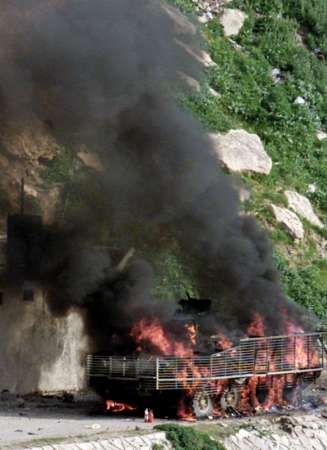
U.S. marine LAV-1s incinerated in Iraq War 1
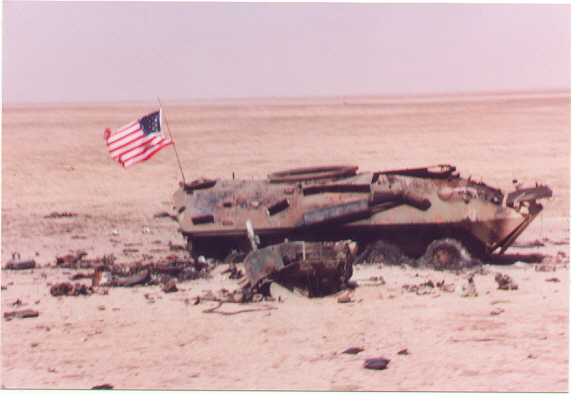
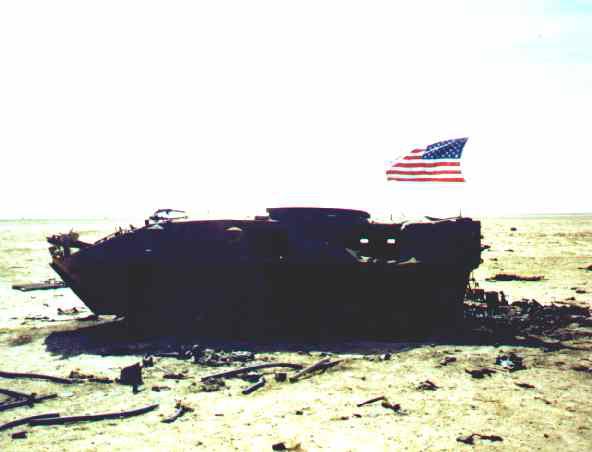
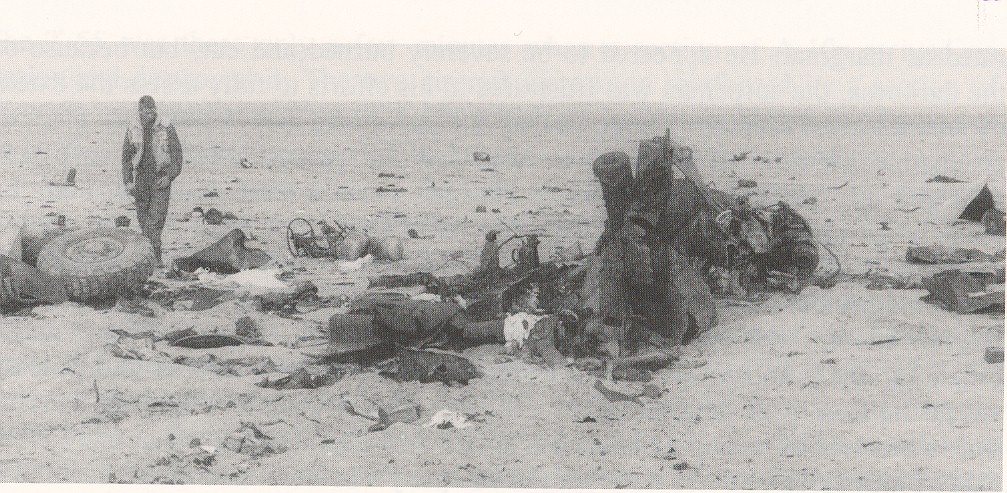
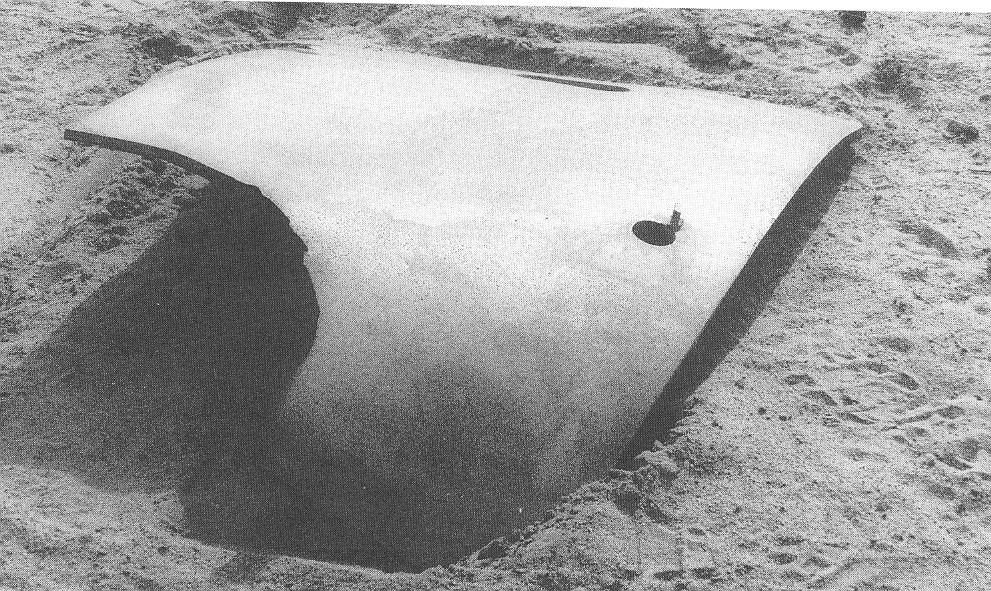
The inefficiency of steel for troop-carrying volume fact of life still exists to this day. The LAV-III/Stryker thinly-armored truck compounds this error of using steel for high volume hulls by placing the hull on top of vulnerable (bullets, molotov cocktails battlefield debris) rubber-tired propulsion/steering means which demands they by oversized by a factor of 28% just to fit on top. These two inefficiencies are compounded in the LAV-III derived Stryker making it a huge target for enemies to aim in on and hit while being a target that cannot be made thick enough or bolstered with enough sacrificial armor layers on the outside to withstand RPGs/ATGMs/autocannon/land mines. We have known since WW1 that rubber-tired armored cars cannot go cross-country at will, which caused the track-laying tank to be created in the first place!
Hull = 20' x 10' volume for 9-man squad x 28% oversize to fit over wheels x 1/2" steel thickness
+
_____________________________________________________________________________
wheeled drive train/propulsion
= 17 tons (LAV-III)
However, for all of this weight, you do not get much available interior volume compared to tracks.
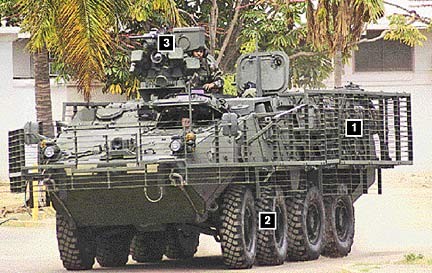
LAV-III/Stryker insides
The answer arrives in the Aluminum Armored Hull Tracked M113 Gavin
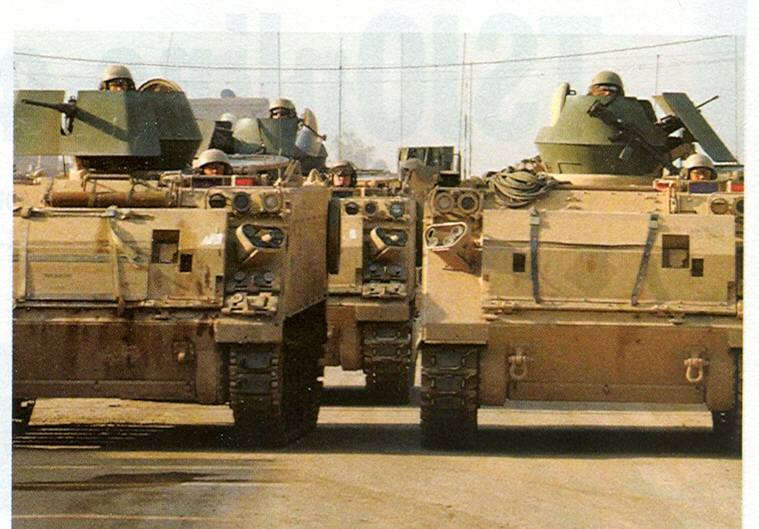
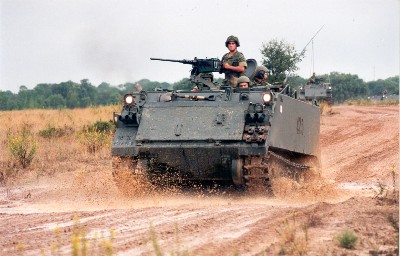
The fully-enclosed, amphibious, air-transportable APC only became practical with the advent of aluminum alloy armor in 1955-1960 with the M113 at the behest of General James Gavin. 3 times lighter than steel, aluminum alloy armor is both hard to deflect bullets and soft to absorb blast and shrapnel effects.
Hull = 20' x 10' volume for 9-man squad x 1.5" aluminum alloy armor thickness
+
____________________________________________________________________
tracked drive train/propulsion
= 10 tons (M113)
M113 Gavin because its TRACKED is 28% more weight/space efficient than vanilla Stryker (LAV-III) because its hull can be more compact saving more weight than just looking at rubber tires and steel track sections. Because M113 is made of aluminum alloy armor its 3x more efficient in hull weight and can be 3 times thicker which also means no need for external support beams which is also weight saved. The point is all things being the same, 300 horsepower in a tracked M113 Gavin means it can have 4 tons of extra armor placed around it just for the sake of protection not to create infantry/propulsion volume before it even gets as heavy as the LAV-III is EMPTY.
Rafael Vehicle Armor Solutions: Up-Armored M113 Gavins Featured
 www.youtube.com/watch?v=tz_LbSjPrOw
www.youtube.com/watch?v=tz_LbSjPrOw
The mistake the Army continues to make with the M113 is to not exploit its potential for sacrificial armor layers on the outside to pre-detonate RPGs which have a shaped charge "blow torch" effect, but only worry about bullets, which resulted in the excellent ACAV gunshield kits but nothing for the shaped-charge threat. To create a 20' x 10' volume for an infantry squad to be carried and increase the hull thickness to 10 inches to defeat RPGs would result in an APC weighing 66 tons! Instead of letting the RPG warhead impact the hull and start to burn its way through, if you pre-detonate it several feet its blow torch effect will be dissipated. A 2-foot stand-off reduces its armor penetration from 10 inches to 5 inches. With the M113 Gavin's ability to have 6 tons of armor fitted no problem around itself with the pre-det layer itself being 1 inch thick or more, the RPG blow torch when it reaches the hull has been lessened to where the hull and spall liner behind it contain it. Place gear in between the pre-det layer as a storage compartment and the RPG effect is even further negated. This pre-det layer should not weigh more than 2 tons and automatically increases bullet protection from 7.62mm AP at the hull to 14.5mm heavy machine gun bullets. It also increases blast protection from land mines we now call roadside bombs or "IEDs" to pretend like they are a new thing as a cover-your-ass (CYA) means when they are not. Reactive armor tiles on the outside of the pre-det/bullet deformation layer defeats RPGs and bigger ATGM shaped charge warheads.
After adding fuel, ammunition, weapons, men into an up-armored M113 Gavin you now have a 17 ton nearly "medium" TAFV. We must not ass u me that if something is medium heavy that its got more armor protection than something that its lighter if its weight is primarily in an oversized box that can only be thin because its made of steel and wheeled propulsion means like the Stryker. The formula for armor protection should be:
Volume x thickness @ rate of material its made of
+
________________________________________ = Total Weight
Propulsion Means Weight
The ARIS SPA waterjets and nose when fitted to the M113 makes it ship-to-shore swim capable, what we call an "AmphiGavin". The irony is that Hunnicutt points out that UDLP/FMC proposed a similar new build vehicle to the USMC that would be a far more nimble and harder to hit infantry squad carrier than the multi-squad carrying AAV-7 and now AAAV/EFV monstrosity they have and are wasting $$$ billions on. The USMC makes the same mistake of scale with their oversized V-22 airplane/helicopter that the Army to its credit rejected with the M44 at the end of WW2. However, the Army made the oversized vehicle mistake with the Bradley tank/infantry carrying vehicle.
Gun-only Tanks
A big gun cannon "tank" does not need a 20' x 10' volume to carry a 9-man infantry squad so its hull can be smaller and more compact. A tank is then able to translate this weight savings into ARMOR THICKNESS to include using steel. If you eliminate the 30 ton turret from the 70 ton M1 Abrams tank, you get a 40 ton VERY THICK hull and tracked chassis made of steel with exotic composites. Since its 4x heavier than a M113 its easy to understand its at least 4x thicker---definitely more so because it needs only the volume for a driver/engine/fuel tanks---probably 10x thicker than a Gavin's hull which comes out above the required 10 inches to defeat RPG shaped charge warheads from the outset. Doing this also makes it impervious to bullets and small autocannon shells.
Man/Machine Interface: what's the Best Way to Fight Mounted?
First off, you have to have something from which to fight mounted. This has always been the greatest struggle in a U.S. military that wants to do the least composed of inflexible minds who are comfortable with "making mountains out of moehills" of garrison minutiae while the bigger issues of victory/defeat, life/death on the battlefield are not taken to heart. So finally in 1960, the U.S. Army led the entire world with the introduction of the first, fully enclosed, air-transportable, infantry squad-carrying TAFV, the M113 APC. Under the Nuclear-War obsessed Pentomic Army concept the Airborne divisions were to get armored mobility by a transportation battalion using parachute-delivered M113s. The requirements for a nuclear battlefield mimic what is needed today to prevail on a non-linear battlefield dominated by high explosives.
http://64.233.187.104/search?q=cache:plXc8AJcFpAJ:www.army.mil/cmh-pg/books/AMH/AMH-26.htm+pentomic&hl=en&ie=UTF-8
Chapter 26THE ARMY AND THE NEW LOOK
Extracted from
AMERICAN MILITARY HISTORY
ARMY HISTORICAL SERIES
OFFICE OF THE CHIEF OF MILITARY HISTORY
UNITED STATES ARMY
The major tactical reorganization to meet the new conditions began in 1956 when the first pentomic divisions and missiles commands were set up to furnish the mobile units and fire support deemed necessary for nuclear war. The old triangular infantry and airborne divisions were replaced by an organization consisting of five battle groups, each a self-contained force capable of independent operations. Manned by 13,500 men instead of about 17,000, the pentomic divisions were directly supported by artillery and missiles that could employ conventional or nuclear warheads, while the heavier long-range missiles were concentrated in the missile commands. The armored divisions required less drastic overhauling, since they were better adapted to the requisite pattern of mobility and dispersion. By 1958 all of the Regular Army divisions had been reorganized; the National Guard and Reserve divisions did not complete their change-over until 1960.
A program to produce ground and air vehicles with the necessary battlefield mobility led to the development of armored personnel carriers, such as the M113 with aluminum armor, that could move troops rapidly to the scene of operations while providing greater protection for the individual Soldier. Since
585
highways and bridges might be damaged or destroyed, dual-capability amphibious vehicles that could travel on rough terrain and swim across rivers and swamps freed the fighting units from total dependence upon roads. Also, transportable bridges and bridge-laying equipment were designed to help speed movement of land-bound vehicles like the new, diesel-powered M60 battle tank that became operational in 1960. The M60 weighed over fifty-two tons, had a cruising range of 300 miles, and mounted a 105-mm. turret gun.
Perhaps the most dramatic efforts to increase the Army's mobility occurred in the field of aviation. To secure both firepower and maneuverability, the Army pushed its development of helicopters and low-speed fixed-wing aircraft. The versatile helicopter had already been used in Korea to move troops and supplies, conduct reconnaissance, and evacuate casualties. Some of the new fixed-wing planes were designed for short take-off and landing to increase their value in forward areas and to carry payloads of over three tons; others were to conduct visual, photographic, and electronic surveillance missions over the battlefield and behind enemy lines. Experiments were also initiated on vertical take-off and landing aircraft that would combine the advantages of the helicopter's small operating area requirements with the greater speed of the fixed-wing plane.
Support for combat troops would have to be keyed to minimum essential requirements. Furnishing the minimum essential requirements in itself presented problems that were by no means completely solved. By rapidly processing requisitions in electronic computers, using fast naval vessels and air transport, delivering over the beaches by means of roll-on-roll-off ships and aerial tramways instead of through ports, and employing cross-country vehicles to steer clear of reliance on road nets, the logistics planners hoped to provide adequate support to the front-line troops
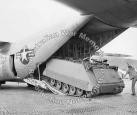
However, General Gavin was now retired and the Kennedy Administration wanted change and mistakenly threw out the M113 mobility for the light infantry "baby" out with the Eisenhower Republican Pentomic "bathwater", The conservative Army brass that wanted command reserved for just narcissistic infantry/armor officers wouldn't have to compete with the other "lower-life form" (but generally smarter) specialty branch officers in a combined-arms Pentomic Battle Group and Division. The Vietnam War exploded from an advisor's war to full-scale American participation war shortly after LBJ instigated JFK's assassination in November 22, 1963. The Army Airborne had M56 Scorpion 90mm guns exposed on a tiny tracked chassis, and the USMC had the T55 tiny chassis fitted with 6 x 106mm recoilless rifles called the M50 Ontos, both of which could have been parachute air-dropped or helicopter transported into battle to render fire support for their walking infantry but no armored personnel carrier even though thousands of M113s were available. Both Army and marine foot infantry generals were content to live with the heavy losses way of war they had suffered during WW2 in both Europe and the Pacific. Some have even suggested that the light infantry mind is basically inflexible; it cannot deal with fast moving and changing situations and thus, keeping it simple to just a rifle and a ruck at a foot slog, one map grid square at a time (click = 1,000 meters) kept them in a comfort zone. Details:
www.oocities.org/armorhistory/airassaulttanksnoexcuse.htm
The Vietnamese guerrillas (Viet Cong) and North Vietnamese Army (NVA) would not allow inflexible minds to be comfortable, be it French or American. Before Gavin retired he had created a group of officers who not only flew V/TOL helicopters, they were fighting hard to create a "Sky Cavalry" that could fly over difficult terrains at 100 mph and be "Air-Mobile" in a faster, impromptu way for 3D maneuver than a parachute air assault. In retrospect, when one researches the dozens of French combat jumps they made during the first Indo-China War very quickly into any suitable terrain opening, the tactic of slow airlanding whatever number of helicopters that could fit then dropping off just men on foot without TAFV protected mobility against a more numerous enemy, dug-in with cached ammunition was unwise. By 1965, the Army had developed a 5-ton machine gun and troop carrying TAFVs called the XM729 and XM733 but the brass in love with reliving WW2 rejected them and condemned their Airborne, Light and new Air-Mobile troops to a foot-slog in the jungles of Vietnam. Though the Air Cavalry proponents were quick-thinkers on their feet, they over-estimated the ability of the fragile helicopter to replace every function of a ground vehicle, forgetting Gavin's admonition in 1954 to have air-delivered TAFVs as key parts of an effective "Cavalry". Read the 1962 Howze Board report for details.
One bright spot of inspiration in this mess was the Army advisors saw the potential of the M113 which was sent over to equip two companies of the South Vietnamese Army (ARVN) who turned them into the "Green Dragons" fitted with multiple machine guns to fight MOUNTED from them. The American advisors were horrified that the Vietnamese did not dismount their infantry short of the objective and fight on foot inline with the APC concept. Vehicles with an ability of its dismount infantry to fight mounted would later be referred to as "Infantry Fighting Vehicles". However, even the passive ARVN were scoring serious successes against the previously invincible VC and NVA using their Green Dragons. The M113 with its excellent cross-country mobility could often move faster in water-soaked Vietnam and shrug off enemy bullets as the men inside poured fire into the foot mobile guerrillas. The advisors also brought in CH-21 and UH-1 Huey helicopters and taught the ARVN how to do air assaults to compliment Green Dragon maneuvers. The enemy decided to adapt to our helicopter and mechanized tactics at the Battle of Ap Bac in January 1963, where they stood and fought from mutually supportive trench lines and concentrated their fire against the vulnerable clear canopies of our helicopters and the M113's tracked commanders manning .50 caliber heavy machine guns. Advisor, LTC John Paul Vann in an O-1 Bird Dog fixed-wing observation/attack plane overhead almost saved the day with a Vietnamese Airborne drop to encircle the guerrillas but the apathetic Vietnamese deliberately jumped in front of the enemy to leave them a way of escape. At the troop level, lessons were learned to not land helicopters within 300 meters of treelines were enemy small arms fire could be devastating and to fit GUNSHIELDS to the top of M113s.
The 11th ACR defending the famed "Fulda Gap" in Germany quickly fitted gunshields which they called Armored CAValry or "ACAV" kits to their M113 who we will now refer to as "Gavins" again since their creator was now Ambassador to France and no longer serving in the Army. When the 11th ACR arrived in Vietnam, they were soon rescuing American foot troops who were constantly being trucked and helicoptered in, then proceeding to walk and be ambushed by the VC/NVA, forming desperate perimeters and calling for supporting arms fires. The enemy began to hug us using "belt buckle" close-assault tactics so supporting arms could not be employed because they were too close to our own troops. Fixed-wing close air support from stalwarts like the A-1 SkyRaider and the new comer, the A-37 Dragonfly which could be "talked on" by an air observer in a O-1 or OV-1 Mohawk or OV-10 Bronco also rushed into battle by the time of the 1968 Tet offensive. The VC attacking throughout the countryside almost took out Saigon and its critical Tan San Nhut air base had it not been for the M113 ACAVs ability to bypass ambushed roads and with operational maneuver converge to take back control of the air base, and then clear out the city with devastating firepower. For the rest of the war, the thousands of M113 Gavins supplied to regular and light infantry divisions like the 1st "Big Red One" and 25th "Tropic Lightnings" were the most successful war weapons we had, winning countless battles and saving thousands of lives. Why the Air Cavalry did not turn to a lighter TAFV like the 5-ton XM729/XM733 or use M113 Gavins and use fixed-wing C-130s to paradrop them or larger CH-54 SkyCrane helicopters to lift them while suffering heavy casualties is still a mystery that may not be discovered considering survivors are likely to protect reputations than offer candid admissions for lessons learned.
As the war raged, over in Soviet Russia, they had learned from the M113 Gavin and introduced a fully-enclosed TAFV infantry carrier, the BMP-1 and scaled-down BMD-1 for her then 8 Airborne Divisions. These featured a turret with a 73mm cannon and a Sagger wire-guided anti-tank missile (ATGM) and firing ports for infantry to fire their AKMs looking through vision periscopes. The ever-insecure American Army brass were faced with an "IFV" thought by some superior to our M113 Gavins considered only to be "APCs". Thankfully, with combat veterans from Vietnam keeping things "real" at Fort Benning, adaptations were made to give M113 Gavins firing ports while keeping the ability to fight on top with ACAV gunshields, as depicted in Hunnicutt's book. If one is realistic, the facts are that the best way to fight mounted with adequate visibility is still on top of the TAFV behind gunshields using machine guns. There will be some casualties from enemy return fire since men are not fully covered. However, if enemy fires intensify from exploding shells, having an ability to "button up" and still fight is a desirable SECONDARY way of fighting mounted. The 1973 Egyptian/Syrian disaster trying to fight mounted from their BMPs from firing ports as the PRIMARY way should have been known as a very, very, bad idea and been a driving force behind the U.S. Army's 1976 task force to evaluate the results of Mechanized Infantry Combat Vehicle (MICV) prototypes that had been created from M113 Gavins. The MICV prototypes generally used a cut-down rear hull area for firing ports with a light 1-man autocannon turret, external rear fuel tanks while retaining a top cargo hatch to fight with ACAV gunshields. The Armored Infantry Fighting Vehicle (AIFV) added a bigger engine, spaced armor and a 25mm BMP-killing 1-man autocannon turret, and had the dismount squad leader in a hatch next to the gunner to land navigate/direct the driver to his front. The MICV or AIFV adaptation with a bigger engine and extra armor could have been fitted to existing M113 Gavins throughout the Army quickly and at low costs. Either the MICV or the AIFV could still swim and be effective INFANTRY carrying TAFVs. However, the Army brass in the 1976 wanted their own BMP complete with cannon and ATGM with a few infantry in back smothered by an oversized 2-man turret that would be a ready excuse to keep them buttoned up at all times and made to fight from firing ports as the PRIMARY way of fighting mounted--the BMP mistake all over again. The hard-learned lessons from Vietnam were tossed aside with disastrous consequences in the future.
The facts always remains that COSTS are always a factor. Unless you are clever and come up with an inexpensive and effective way of doing something your costly, unimaginative solution will mean you can only have a few of them, as the M75 and M59 proved. The Bradley was no different as only roughly 4,000 were ever produced. The good news is that the simpler, easier to maintain basic 7.62mm AP bullet-stopping M113 Gavin has NOT been replaced by the Bradley and stands ready to save the day to finally give our 3D maneuver forces the armored mobility means they have always needed as Gavin realized back in 1947 after the WW2 blood bath. The Army has over 14,000 M113 Gavins all of which which can be adapted in one fell swoop to achieve capabilities critical for today's non-linear battlefield (NLB) where enemy high explosive attacks have created locally devastation on par with the nuclear battlefields that the vehicle was designed to cope with in the first place. While it could be affordable to alter the hull form of the M113 Gavin in back to create secondary firing ports, these funds would be used for better applique' armor, propulsion, weaponry and C4ISR means. There is indeed a simpler way to create a secondary mounted fighting capability on M113 Gavins by using different HATCHES.
EXCLUSIVE!
First, all of the doors within the rear ramp of M113 Gavins should be replaced with a door with a window periscope and a firing port "universal mount" that claps around either U.S. or captured Russian style weapons as far rearward on the action as possible for center of balance. This would provide rearward observation/fires and security.
Next, the driver's top hatch needs to swing flat to his left like on the M1 Abrams' driver's hatch not like the current flip-back hatch which impedes the Track Commander's ACAV gunshield when turned to that direction. Above his head in the bulge built into his top hatch would be a M231 5.56mm firing port weapon (FPW) with a 100 round C-MAG in the universal mount which he could fire with one hand as he drives with his other hand and legs while buttoned up. A brass catcher bag will keep hot, spent 5.56mm cases from landing on his head or wiggling into his Nomex. Some will say this is not "safe". Well, WAR is not safe. Its high time we start acting like war professionals and admit that in war extreme measures like bristling vehicles with weaponry are needed to prevail. We need frontal fire capabilities if the Gavin TC has an ACAV cupola mounting that when he buttons up cannot be fired from. Some Gavins can and should have a 1-man autocannon turret instead of the ACAV manually-operated .50 caliber heavy machine gun that will offer frontal as well as 360 degree firepower even when buttoned up. Costs are a factor here, what we do MUST BE DONE FOR THE ENTIRE ARMY NOT JUST PARTS OF THE ARMY IF WE ARE TO PROPERLY ADAPT TO THE NLB. If the TC is also the dismount Squad Leader and a 1-man autocannon turret is fitted, the driver should with a helmet mounted sight and his driving screen should have an aiming circle to fire the autocannon to support his dismounted comrades and protect the vehicle if he is alone in it. If he does not have a powered autocannon, the driver's top hatch FPW can "scratch the back" of a Gavin ahead if enemy infantry to to get close.
Even though the TC's cupola is in the front center of the Gavin, there IS enough space behind the driver for a square top hatch for the dismount squad leader to sit, though this is still time/labor/cost. Moving the TC's cupola or 1-man turret to the far right for more space for the dismount squad leader is even more costs to consider. On top of his hatch should be a revolving persiscope like the British Warrior MICVs have in addition to vision blocks. This periscope might be a video camera with the ability to zoom in as well as have image intensifier and forward looking infared (FLIR). What the squad leader sees should be piped into the back and shown on a large screen for his dismounts to see for a briefing before dismounting. Its a given that any 1-man autocannon turret fitted to Gavins should be stabilized for fire-on-the-move and have both image intensifier and "thermal" vision. The point is that the dismount squad leader has to SEE out to land navigate/tactically command the vehicle while from open hatches and buttoned up.
The very first way thought to give the troops in the back of M113s firing ports is still a sound idea, add a raised roof structure and keep the open top hatch as an option. The Israelis have modified some of their M113 "Zeldas" in this way. The problem is that cutting hulls will cost money and time which we are short on. A simpler way would be to fit a raised bulge top hatch with vision blocks and firing ports so two men can face left and right and fire compact M231 5.56mm firing port weapons with 100 round C-MAGs. Longer weapons could also be fired using the universal clamp but there may not be enough space for 2 Soldiers to stand behind them and fire them. Before closing the firing port top cargo hatch, the two ACAV wing machine guns are removed and the shields swung forward and secured in this position so the firing port guns will have clear fields of fire. In that case, Gavins in the formation would alternate weapons directions when buttoned up. When not buttoned up, the hatch should LOCK INTO AN UPRIGHT OPEN POSITION TO ACT AS A REAR SHIELD like the Bradley's top hatch can be positioned. (See, I have something good to say about the Bradley after all!).
If U.S. forces are "thunder running" and must button up to run a gauntlet of enemy fire to get to operational objectives, they can use enemy ammunition captured by designated "Vulture" squads to pour fire out of their Gavins, conserving their units of fire for American weaponry which they have a higher level of skill when more accurate fire effects are needed. Firing weapons out of vehicle ports is not accurate and is only good for close-in security. However, if the enemy forces us to button up using air burst munitions we must have 360 degree fires to thwart RPG gunner's and enemy versions of "Saving Private Ryan" sticky bomb attackers for close-in defense. Experience has proven time and time again that a powered 360 turret on the TAFV cannot provide adequate 360 security since its gunner can only face in one direction at a time. Having the mounted infantry in back able to see and contribute to the fight not only makes 360 security possible it eliminates forever the "Bradley disease" that has severely damaged the concept of mechanized infantry in the U.S. Army to such a degree that most infantryman avoid service in mechanized units like a plague with the tragic consequences that life-saving and war winning equipment, tactics, techniques and procedures (TTP) are dismissed from the outset for absurd personal, emotional, cultural reasons.
The Medium Bradley Mistake and How to Fix It
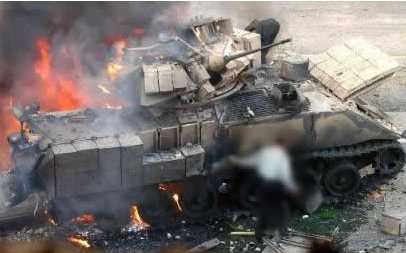
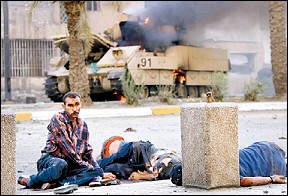
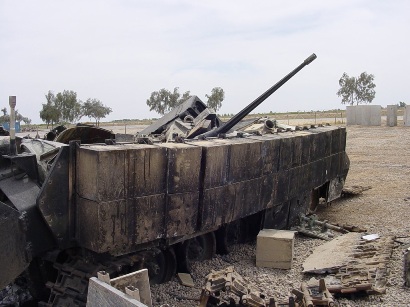
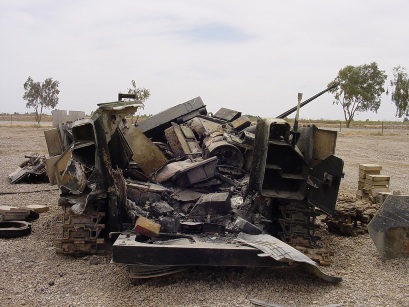
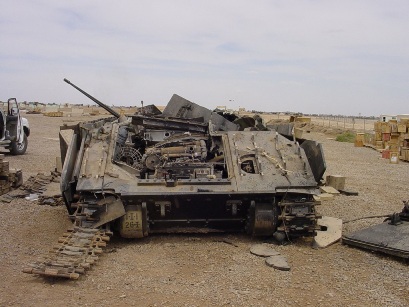
 www.youtube.com/watch?feature=email&v=bZtpO53bYm0
www.youtube.com/watch?feature=email&v=bZtpO53bYm0
Bradley after center fuel tank-fed fires melted them down to a pile of metal; Army brass still refuses to get center fuel tankage out of our Bradleys
Army-created Tragedies: MOVE Bradley fuel to outside like M113A3 Gavins NOW
http://news.aol.com/article/portrait-of-burned-soldier-richard/722436
Burned Soldier Painting Goes to Museum
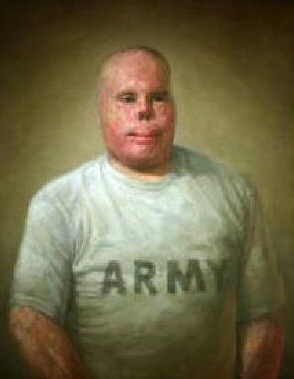
By MICHELLE ROBERTS, AP
posted: 13 HOURS 50 MINUTES AGO
SAN ANTONIO (Oct. 19) - Retired Army Sgt. Richard Yarosh has gotten used to the stares. His face is blanketed in knotty scar tissue. His nose tip is missing. His ears are gone, as is part of his right leg. His fingers are permanently bent and rigid.
All is the result of an explosion in Iraq that doused him in fuel and fire three years ago.
An Unique Honor Matthew Mitchell, AP4 photos
This life-sized oil portrait of retired Army Sgt. Richard Yarosh will go on display at the Smithsonian's National Portrait Gallery in Washington later this month. Yarosh, 27, was left scarred and disfigured after an explosion while he was fighting in Iraq three years ago.
An Unique Honor
This life-sized oil portrait of retired Army Sgt. Richard Yarosh will go on display at the Smithsonian's National Portrait Gallery in Washington later this month. Yarosh, 27, was left scarred and disfigured after an explosion while he was fighting Iraq three years ago.

Matthew Mitchell, AP
"I know people are curious," he said. "They'll stop in their tracks and look. I guess I can understand. I probably would have stared, too."
Soon, a lot more people will be staring at Yarosh's face but in a very different way: A life-sized oil painting of him will go on display at the National Portrait Gallery at the Smithsonian Institution in Washington later this month. The portrait, by Matthew Mitchell, is a finalist in the Outwin Boochever Portrait Competition, which recognizes modern portraiture at the gallery known for its collection of notable Americans.
The gallery received more than 3,300 entries. Many are less conventional portraits, including video and photos, but others, like that of Yarosh, draw strength from the traditional head-and-shoulders composition, said curator Brandon Fortune.
Mitchell's use of the style — historically reserved for nobility, a high-ranking military officer or a president, not a disfigured Soldier in an Army T-shirt — democratizes such paintings, Fortune said. "The portrait is clearly meant to honor him. I think that contributes to the gravity of the presentation," she said.
The Yarosh painting is part of a series of portraits by Mitchell begun four years ago, when he set out to paint 100 military personnel or others who served in Iraq and Afghanistan. With 30 completed so far, each of the portraits is 26-by-30 inches with roughly the same head-and-shoulders framing. Yarosh's portrait is No. 23.
"There's a huge amount of people who have been deeply touched by these wars in America, and these wars are obviously some of the most formative events in the world," said Mitchell. "Yet, most people in America don't need to pay attention to these wars whatsoever. They don't feel compelled." The 38-year-old Mitchell, of Amherst, Mass., asks each of his subjects to write a brief description of his or her experience to go with the portraits. Yarosh's includes the line: "That day started the same as every other day, but that day has never ended."
The day was Sept. 1, 2006, and Yarosh was manning the turret of a Bradley assault vehicle, patrolling a road that he'd been on "a million times." Only this time, the vehicle hit an explosive device. The fuel tank blew, and Yarosh was instantly covered in flames.
He took a blind jump from the top of the vehicle, breaking his leg and severing an artery that would eventually force an amputation. He rolled around in the dirt, but with so much fuel, he couldn't get the fire out. He lay there, next to the burning vehicle, and gave up.
"I wasn't in pain. I could accept the fact that I was going to go. This was how the Lord would take me," he said.
But for reasons he still can't explain, Yarosh rolled to his right one more time and suddenly fell into a canal, where the flames were extinguished. Fellow soldiers pulled him from the water even as his body armor disintegrated into ash, and he survived. One of the other soldiers in the vehicle did not; Sgt. Luis Montes died about a week after the blast.
Yarosh, now 27, spent more than two years in full-time treatment and rehabilitation at Brooke Army Medical Center, home of the Army's only burn unit. A public affairs officer who had been contacted by Mitchell connected the two men.
Yarosh, who moved back to Windsor, N.Y., after his retirement in January, concedes he was a little uneasy when he sat for the portrait because he worried about how an artist, likely to be more liberal, might depict him. Still, Yarosh agreed because he thought having his portrait done would be "super cool."
He sat for sessions over two days. Mitchell developed the basic outline during the sittings and took photos and video to complete the portrait later.
The artist, who makes his living in part by doing traditional commission work, said Yarosh's injuries left the soldier without the typical landmarks — nose, ears and other features — that help an artist see a person's character.
But somehow, "I felt it was done when I felt I could see his personality. Still, that's a big mystery to me. I don't know how it happens," he said.
Yarosh was astonished when he saw the completed portrait.
"It was perfect. I couldn't believe that he captured me," he said. "It captures my pride. I'm proud of the way I look. I'm proud of the reason for the way I look."
The winner of the competition will be announced on Oct. 22, with a top-prize of $25,000 and the opportunity to do a commissioned work for the gallery's permanent collection. The exhibit of 49 finalists, including Yarosh's portrait, opens on Oct. 23 and will be on display until August.
http://news.aol.com/story/_a/for-burned-troops-stress-and-deep-bonds/n20070715065609990002
For Burned Troops, Stress and Deep BondsAP
Posted: 2007-07-15 06:56:41SAN ANTONIO (AP) - The five badly burned Soldiers arrived around 11 p.m., sedated and swathed in bandages from head to foot - the screech of the plane's wheels on the tarmac and waiting ambulances marking the end of a 7,500-mile journey.
Dr. Kevin Chung had just returned from dinner as the ambulance convoy zipped through the gates of Brooke Army Medical Center. He paced back and forth from his office to intensive care, waiting for the Soldiers who were coming in from Germany, after being evacuated from Iraq.
A three-continent marathon, and this was the finish line.
Chung had reviewed the Soldiers' charts and ordered medicine. He donned a blue surgical gown and put on his mask and gloves as the men were wheeled in one by one, tethered to a blinking, beeping, buzzing nest of tubes, ventilators and monitors.
Now Chung and some 30 doctors, nurses and others took over.
They cut open the men's bandages and, using diagrams of the human body, mapped the Soldiers' burns - shading in red for third-degree, blue for second-degree - to plan for surgery.
They called the Soldiers' families. They needed permission to operate.
Quickly.
The men had been injured days earlier when a roadside bomb in Iraq turned their Bradley fighting vehicle into an inferno. One man who had escaped ran back to help a trapped comrade.
"This one's the hero," Chung said, as the first stretcher rolled in.
"They're all heroes," a nurse replied.
The "hero" was in the worst shape, with burns ravaging more than 70 percent of his body. His skin was leathery, his eyes swollen shut, his body bloated.
Chung did a bronchoscopy to check his lungs. He threaded a fiber-optic scope into the tube connecting the Soldier to a ventilator. Tar-like soot deposits appeared on a video monitor.
To Chung, it looked as if someone had smoked 100 packs of cigarettes in 10 minutes.
If this Soldier - the one who had escaped - had so much lung damage, what about the men who had been trapped?
He examined them and answered his own question.
Their lungs were worse.
Brooke's burn center - the only one of its kind for the nation's military - has its own rhythms and rituals.
The center's 40 beds are tucked in a fourth-floor wing of the sand-colored hospital at Fort Sam Houston. In the halls and on the walls, there are constant reminders of the war - the scarred young men, the clocks set to Iraq and Afghanistan time.
This is a place where the wounded celebrate small steps toward recovery, even bending a pinkie finger, and mourn the loss of the pain-free lives they once led. Where patients can spend months in intensive care and years in rehabilitation.
It's a place where a groan or a clenched-teeth grimace speak more eloquently than words.
And it's a place with a quiet sense of urgency.
Doctors operate in womb-like, 90-degree heat, sometimes six at once working on a Soldier; nurses, in boots, masks and long gowns, sweat as they scrub down patients in steaming showers; families congregate, longing for the day loved ones will emerge from the cocoon of bandages.
In another era, another war, many patients probably would never have made it this far.
But troops today have better body armor, fast evacuation from the battlefield to war zone hospitals, then state-of-the-art treatment in Germany and the United States.
Brooke has special teams that fly to Landstuhl Regional Medical Center in Germany to bring home the most severe cases on a C-17 transport, sometimes handling emergencies in midair.
A Soldier burned in Iraq can be in a hospital bed in San Antonio within 72 hours, sometimes less. In Desert Storm, it took nearly 12 days. In Vietnam, it was closer to 17 days.
Once patients arrive at Brooke, skin grafts are usually done within 24 hours to stave off infection, the major cause of death. Decades ago, doctors waited days or weeks to do surgery.
"The faster you get the burn off the patient, the better off you're going to do," says Dr. David Barillo, chief of the flight evacuation team.
Brooke's burn center also treats civilians. But these days there is a steady flow of wounded from Iraq and Afghanistan - more than 570 thus far, of which only about 6 percent have died. Many survivors, however, are permanently scarred. Some also suffer from blast-related wounds, such as head injuries or fractures. Others can't walk, sign their names or tie their shoes.
"We now have an entirely new population of burn survivors ... with oftentimes lifelong and life-changing injuries," says Dr. Evan Renz, a Brooke surgeon.
Some will recover. Others will learn new ways to become independent.
"You have to believe that you're doing the best thing for the patient by helping them survive," Renz says. "You have to believe that in the end, when all is said and done, they will be glad they made it through."
There are always people, he says, who will look at severely burned patients and ask why put them through all the agony.
"We try not to judge too much," he says. "When you're talking about how far should you go to save someone's life, I think in the case of these tragic injuries you have to be realistic. You have to look at what can be done. Just because we can do it, should we do it?"
He pauses, then adds: "I certainly have no regrets about those things I've been able to do."
Chung woke from a quick nap on his office couch the morning after the five badly burned Soldiers arrived, and walked down the hall to check on them.
All were stable. But the news quickly turned grim.
One Soldier went into shock. His heart, lungs and kidneys failed. He never regained consciousness to see family members who had flown in to be at his bedside.
It was not Chung's first loss, but, he says, every one leaves him shaken.
Chung had treated seriously wounded troops as a fellow at Walter Reed Army Medical Center. But Brooke, he says, is more intense. Patients rally, nearly die, rally again - and then sometimes lose the struggle.
"I can't think of a more devastating injury," Chung says. "In the most tragic instances a lot of us say to ourselves ... sometimes life is worse than death."
Some burn survivors say that, too.
"We have patients that tell us, 'I want to die. I want to die. Let me go.' ... That's very tough," Chung says. "The best we can do is manage the pain."
Of the five patients arriving that night, one was transferred out of intensive care.
The "hero" was rebounding, too. He was talking with his family. Everyone was excited. But it was that roller coaster again. This was the top. Then, the dip: An abdominal infection set in.
The "hero" died. Within three weeks, four of the five were gone.
Chung was reeling.
"You start wondering, 'Do I even matter?"' he says. "You start doubting whether you're making any difference. Looking back, I felt I was very naive. I was thinking, 'I'm a young physician. I have all this knowledge. I can do all these great things. Maybe I can help save them.' You quickly realize that that's not the case. You have absolutely no control. I felt completely helpless."
And stressed out.
He couldn't sleep. He was irritable with his two young children. He didn't always want to talk with patients' families.
Chung knew he had to change - and he did, in several ways.
Working with other doctors, he immersed himself in developing a new treatment to help burn survivors in shock. He also made sure he spent more time with his kids.
Sleep began to come more easily. So, too, did energy for the next day's emotional whirlpool.
"I still have my compassion," Chung says. "I want to hold on to that."
He needs it.
"You walk a tightrope," he says. "I tell the family members that they need to be realistic. ... At the same time, I don't want to be the person to take away hope. How can you justify giving up on anybody?"
Chung always reminds himself of the most critically burned patient he helped treat who survived.
EXCERPT 2:
Chris Edwards is in Year 3 as a burn center regular.
The Army staff sergeant was wounded when a 500-pound bomb exploded under his Bradley as he was crossing a bridge in Iraq. Sitting just inches from 100 gallons of diesel fuel, his body was set ablaze.
Edwards was burned over 79 percent of his body.
Since then, he has endured 34 surgeries. He ticks them off as if reading a grocery list: Grafts over his entire body, eye operations (including a cornea transplant), corrective work on his ankles and fingers, holes drilled through his lower right leg bones and heel and metal rods inserted to stabilize them.
And more.
"You start thinking, what did I do to deserve this?" says Edwards, who also served in the marines. "It really tests your faith. Not only that, you're really thinking: What did my family do to deserve this?"
Edwards, 36, wonders how he can make up lost time with his 5-year-old son and make his older boys, 10 and 13, understand why he can't play catch as he once did.
He worries, too, about pressure on his wife, Tammy, who helps bathe him. "That's not something you just expect to do when you marry someone physically fit," he says.
Then there's the pain. Some days, it's tolerable.
Other days, he says, "I just ... beg somehow for God to kill me and take away the pain and let me die. ... It's like walking on hot coals, having your hands put in boiling water ... and breathing with a 10-ton weight on my chest."
But as hard as it has been, Edwards still finds humor - as he has all his life.
"If you're a patient and you laugh for a second, that's one second more that you don't have to worry about how bad things hurt. ... For that second, you're a regular person. I try to keep people laughing as much as I can."
Sgt. Shane Elder patched up the wounded in Iraq and sent them home to be healed.
Now he's home, treating burn survivors at Brooke, gently massaging and stretching their scars so they don't shrink and turn fingers into claws.
Elder, a former medic with the 173rd Airborne Brigade, is an occupational therapist's assistant. Off-duty, he's just one of the guys, hosting an occasional poker game for patients at his home or joining them for dinner or a movie.
"They're my comrades," he says. "You don't work with these guys an hour, an hour-and-a-half every day and just talk about your burn scar. They become your friends."
One of his first patients was a severely burned marine who had part of his brain's left frontal lobe removed because of shrapnel. Elder figured he wouldn't be able to talk. But when he entered his room, the marine started chatting amiably.
The men found they shared the same dry wit and taste in rock music. And when the marine was about to be discharged, Elder invited him over.
Elder prepared his older son, then 3, knowing he might be frightened by the marine's disfigured face. Instead, the little boy was fascinated by his prosthetic arm and asked:
"Are you a robot?"
"Sort of," the marine replied.
After that, Elder's son would joyfully squeal the marine's name every time he visited. And last fall, Elder was a groomsman at his wedding.
At Brooke, Elder helps patients face their fears.
"They'll say, 'I'm a 19-year-old single male,' " Elder says. "'What girl would ever want to date me? How will I ever have a family? I was a young healthy stud fighting the good fight. Now I need help buttoning my pants in the morning."'
His advice: Move on with your life.
"You're not the same person you were before," Elder tells them. "If anything, you're a stronger person. ... Get back out there."
Marine Cpl. Roy VanWey is plotting his path away from the burn center.
A year ago, a bomb turned VanWey's Humvee into a fireball, killing three marines who were with him and leaving him with burns over 70 percent of his body.
Since then, he has been through 10 surgeries - he recently had one to hold his head straight. Slowly, he is regaining his independence. He can now spool pasta, draw and sign his name, even though he lost most of the fingers on his right hand. But he still is adjusting to his changing face - pink, blotchy, raw.
He knows people stare when he goes to the mall, the movies or out to dinner.
"When I'm talking to people, I feel like the same person inside," he says. "But when I look in the mirror, I feel like I'm looking at a stranger."
His wife, Cassi, offers a visitor a laminated marine photo identification card showing a handsome man with bright eyes and a wide smile. Then she turns to her husband of 18 months and says: "I don't care what you look like. I love both faces the same."
With her at his side, VanWey sorts out his life after Brooke, "mourning the death of the person I used to be," he says, "and having to come to terms with who I'm going to be the rest of my life."
Determinedly, he looks ahead.
"I've got to make the best of it," he says. "At least I'm alive."
The book and black comedy movie, "Pentagon Wars" based on USAF Colonel Jim Burton's fight to make the Bradley fighting vehicle survivable, also shows how the scout vehicle mission was merged into the already oversized vehicle infantry carrying and BMP-killing tank. A simpler and wiser M113 Gavin upgrade was rejected perhaps for selfish, power and money hungry reasons by the Army brass who wanted a new cash cow from Congress. Hunnicutt's book begins with a disgusting forward by retired Army General Sheridan covering his ass as former project manager (PM) of Bradley by making an incredible series of lies about how the Bradley can swim, enable the infantry inside to fight, their leader to command, and be cross-country mobile and survivable. Hunnicutt's book damns and contradicts everything he says. His book shows Bradleys requiring swim skirts to cross rivers/lakes. Compare to the A2 model Bradleys in his book, no swim skirts = Bradleys cannot swim. Look at the weight = 33 tons, you're not going to make it across southeast asian rice paddies in a Bradley. Where is the Bradley commander? In the turret. How can he get out to command dismounts? How many dismounts? Only 6-7. While the Bradley has a double-thickness hull of spaced laminate armor to ward off 12.7mm heavy machine gun bullets compared to the M113 Gavin's 7.62mm bullet stopping hull, there is no laws-of-physics "free lunch" on planet earth, and the former is twice as heavy at 20 tons; place the oversized 2-man turret on top and voila! 25-ton "medium" TAFV that no longer can fly by helicopters, C-130s, swims or moves cross-country at will like lighter TAFVs can. You cannot have it both ways; even though Sheridan claims we can with the Bradley. Survivable? Army rejected fuel tanks on outside like M113A3 Gavin has and Hunnicutt shows this, too.
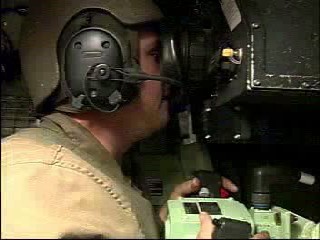
Simply put, the Army blew it in 1976 with the infamous "TBAT-II" (TOW missile, 25mm Bushmaster autocannon, Armored Turret, 2-man) decision making the Bradley an oversized gun/missile tank.I guess if stupidity has a slogan, its no longer stupid? The mechanized infantry solution was (and still is) to improve the already outstanding air-transportable and amphibious M113 Gavin by adding spaced armor, simple firing ports to fight when buttoned up, while retaining ability to fight from top troop hatches and have the dismountable troop commander in his own hatch by the side of the track commander in a modest 1-man turret (lesson we knew from the M59). This vehicle, the Armored Infantry Fighting Vehicle (AIFV) is in use today in South Korea, Holland, Belgium and Turkey. A BMP-killing 25mm autocannon is fitted in most of these AIFVs. The 1976 Board composed of WW2 tanker's employing their narrow-minded gunner's mentality and demanding a 2-man turret be employed, made it then necessary for an entirely new, oversized vehicle to be built from scratch to retain even some infantry carrying capability in the back after fitting a 2-man turret. A tank can afford a 2 or 3 man turret's size and weight because its compensates by a compact engine/fuel/driver only hull. Place a tank turret on an infantry carrier and you have the M44/M75/M59 monstrosity plus a huge turret on top! The Army brass apparently wanted the 25mm BMP-killing autocannon so the Bradley could accompany the M1 Abrams heavy tank as it killed Soviet medium tanks in a 72 hour defense of Germany as an American "Tiger defensive tank". The Abrams is the "male" tank with the big gun, the Bradley is the "female" tank with an autocannon (machine gun shooting explosive bullets) to saturate the area and suppress/kill infantry for the Abrams not to be killed by RPGs/ATGMs. They could have got these capabilities with a 1-man autocannon turret on up-engined M113 Gavins, but at far less cost, less money means less power and prestige in Washington D.C. during the Reagen-era build-up to spook the Soviets into an arms race that would economically collapse them. Fine, use Bradleys to accompany the M1 Abrams defending Fulda Gap as 2D maneuver forces but upgrade M113 Gavins for the global cavalry we needed for 3D maneuver leading 2D forces if they have to invade an Iran. However, without a "cavalry" branch to fight for and get funding to keep bold, 3D armored maneuver vibrant, the M113 Gavin stayed in its "vanilla" state as the main vehicle for everyone else who couldn't heavy up into the few Bradleys that could be purchased. The light, foot infantry languished in their inflexible, narcissistic state of rifle-in-the-hands, ruck-on-the-back Task Force Smith, LZ X-Ray, Koh Tang Island, Beirut default, except for the Airborne 3D maneuver invasion of Panama where light TAFVs were employed with stunning success in coup de main.
The Bradley is not an infantry fighting vehicle to control any type of terrain, its an escort, machine gun tank with some security guards in back (armored infantry). The decision to have a 2-man turret just so a gunner could constantly press his eye against an optical sight as the Bradley Commander (BC) stuck-in-the-turret tells the driver where to go as tactician/navigator makes the gunnery of the vehicle take precedence over the few infantry in the back resulting in empty Bradleys as infantry who don't want to be second-class citizens opt for the light infantry. Having defacto tankers in turrets who do not dismount ordering around permanently owned, underclass, in-the-dark dismount infantry is what the author calls "Bradley disease". Today's technology makes a 2-man turret not necessary, a helmet-mounted sight would enable the TC in a 1-man turret to fire from the open hatch and can drop down and look into a TV screen to "gun" the vehicle as the Infantry Commander steers/navigates the vehicle. The infantry dismount squad leaders, platoon sergeants and leaders should command TAFVs from their own separate hatches not be stuck in turrets pre-occupied with gunnery. The two-man division of labor can still exist between tactical maneuvering and gunnery in an "infantry fighting vehicle" it just should not all take place in one 2-man turret which throws the entire vehicle's proportions off balance. In a nutshell, retrofit the Bradley so its a larger, heavier version of the AIFV.
The Bradley has tracked mobility and shoot-on-move 25mm autocannon which have been decisive in combats in Iraq. These virtues prove that we must stop the road-bound, has-to-stop-to-shoot its .50 caliber pop-gun Stryker truck mentality.
The Bradley's hull is thicker than as-is M113 Gavin....but only in some places....
According to several sources, particularly Hunnicutt, the hull of the Bradley is only 1" thick aluminum alloy armor compared to the M113 Gavin's 1.5 thich hull. The Bradley's SIDES, BOTTOM, REAR have belts of spaced laminate armor. These belts are 2 x 1/4" plates of high hardness steel spaced 1 inch apart with a 3.5" spacing from the hull. A picto-gram is below:
Bradley
Hull Spacing Plate 1 2
1" 1"
__
__]-------------->[]-------->[]
3.5" 1/4" 1/4"
_________________________________________________
3.5 + 1/4" + 1" + 1/4" = 5 inches thick total
As you can see, this is not enough to pre-det a RPG shaped-charge which can burn though 10 inches of solid armor plate but it helps.
However, the FRONT and the ROOF of the Bradley is only 1" thick aluminum alloy armor---LESS PROTECTED THAN THE HULL OF THE M113 Gavin!
This is why the A2 model Bradleys have thicker side skirts and a plate of armor on the front glacis, however STILL NO RPG PRE-DET STAND-OFF because ERA tiles are ASS U MED will be provided by cheap skate garrison BS Army (NOT).
Bad Internal Fuel/Ammo Arrangement
Add fact that Bradley's FUEL TANKS ARE IN CENTER co-located with 25mm turret ammo and you can see why Bradley's have not done so well in Iraq protecting our Soldiers with armor protection; they've done well with 25mm autocannon firepower and tracked mobility but not as well as their 33 ton medium weight would otherwise suggest.
Yes, we can fix Bradleys by removing fuel tanks to left/right rear M113A3 Gavin style.
Yes, we can and should replace with a lighter, lower 1-man 25mm autocannon turret to free space for entire 9-man infantry squad that is not smothered in back that can fight from rear open cargo hatch M113 Gavin ACAV style.
Yes, we should space the Bradley's skirts at least 12 inches and not rely on ERA since dual warheads will blow these tiles away.
But NO----after doing all of this will Bradleys be able to fly by C-130s or Army helicopters for 3D maneuver useful for our light units. (see below) 10.5 ton M113 Gavin LIGHT TAFVs can. Gavins can swim, Bradleys cannot. Gavins can go x-country at will, Bradleys cannot.
Yes, we should place ceramic tiles on the outside of ALL our tracks, but this is costly and this will not happen if we are wasting most of our money on gadgets like air conditioning and fixing the defective machine gun stations on Stryker trucks.
2. The light modular brigade RSTA Squadrons WILL BE ALL HUMVEE TRUCKS. We could not even send them forward in 1991 nor 2003 when invading Iraq...but lo and behold in the future because they have LRAS (huge thermal optic on top) they will be able to?
Only as long as no one is shooting at them or has land mines planted ahead.
The RSTA solution that will work best for either heavy or light brigades is M113 Gavins and M8 Buford/Thunderbolt/Tracer light tanks not more Humvee/Stryker trucks or even more Bradleys.
THE BRADLEY IS NOT PROTECTING OUR SOLDIERS AS WELL AS ITS MEDIUM WEIGHT WOULD SUGGEST BECAUSE ITS FUEL TANKS ARE IN THE CENTER AND ITS ARMOR SKIRTS ARE BOLTED DIRECTLY TO THE HULL WITHOUT RPG PRE-DET STAND OFF BECAUSE ERA TILES ARE EXPECTED TO BE FITTED. When ERA tiles are not there to stop a RPG blow torch it can reach the fuel which ignites, sets the 25mm ammo off and explodes the entire vehicle. Also, having ammunition stored in the floor and TOW ATGMs inside the hull are helping a land mine blast explode the vehicle from inside-out.
Even though the M113 Gavin has in places a thinner hull, its fuel is on the outside, doesn't have volatile ammunition/missiles inside and fitted with a pre-det armor coupled with its smaller size to hit makes IT THE MOST SUCCESSFUL VEHICLE IN IRAQ PROTECTING OUR MEN. More men have died in 300 Strykers, roughly 500 Bradleys and yes, 500 M1s than in 1, 700 M113 Gavins in Iraq.
What the Army relented on (not good enough)
* Fuel tank still in center
* Ammo still in hull
What LTC Burton Wanted (and we still need to do)
* External M113A3 Gavin-style fuel tanks
* External storage of 25mm ammo
2009 UPDATE: the Greedsters at BAE always trying to foist off too-heavy Bradleys upon the Army are NOWWWWWW offering them with external fuel tanks.

Too bad one of the burned Soldiers wasn't one of the sons of someone at BAE's "management"--and maybe this would have happened sooner. Don't get too complacent; IT STILL HASN'T HAPPENED YET. The Army staff now wants to lust after a v-hull shaped FCS, ehh GCVs and waste another 10 years feeding R&D monies to GDLS/BAE to not produce anything--so a decade from now they will be richer and the Soldiers will have NOTHING because we couldn't afford new vehicles TODAY we sure as hell are not going to be able to replace all our vehicles with new ones then.
The tragic preventable deaths of dozens of Soldiers in Iraq demands that the disgusting central fuel tank in the Bradley needs to be removed to the right/left rear as in the M113A3 Gavin so penetrations do not ignite fuel fires that set off 25mm ammunition and explode the entire vehicle. The extra armor on the Bradley was bolted directly to the hull to save width with the expectation that ERA tiles will be added to diffuse RPG shaped charge blow torches. Wake up. This is the Army. The ERA tiles were never bought in quantity to fit to everyone. Remount all applique' armor so it has stand-off to pre-det RPGs even if ERA tiles are not fitted. Make the hull "dry" so there's no fuel inside if anything does penetrate.
Bradleys lucky to have ERA: most do not
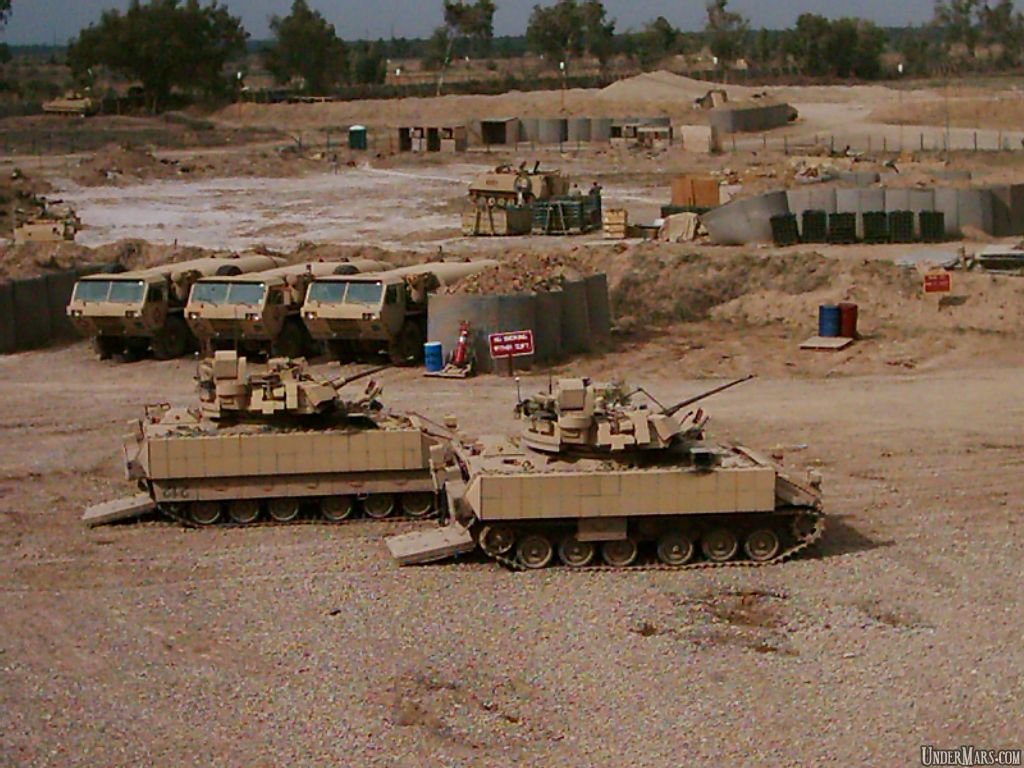
When the battlefield is properly understood as being in either closed or open terrain, it becomes clear that two force types are needed; 3D and 2D maneuver capable. The M113 Gavin with M8 Buford light tanks form the 3D maneuver force that can fly, swim or go cross country without hesitation. Call it "Air-Mech-Strike", "Cavalry", whatever. The 2D maneuver force once the Abrams heavy tank gets a more fuel efficient engine to be able to do long distance offensive campaigns, will still need a female escort tank in the Bradley for autocannon and dismountible infantry. It must be as armor protected as possible by eliminating its huge targeting silhouette by a smaller 1-man autocannon/ATGM turret. Its TOW ATGMs must be fire & forget so the Bradley doesn't have to stop to shoot/track. The 1-man turret will free space so a full 9-man infantry squad can be carried and offer a top hatch/revolving cupola for the dismount-capable infantry leader to see to land navigate/tactically direct not blocked by a huge 2-man turret. The infantry squad, platoon and company WOULD NOT own the new Bradleys and crews. They would train as light infantry not dependant upon their Bradleys with the Bradley's 2-man crews in a separate Delta Engineer Cavalry (ECAV) troop that belongs to Battalion who sees to it that both light infantry and ECAV units train together regularly to include the infantry able to operate the Bradleys as back-up crews. This same Delta ECAV troop structure would be done in light battalions but using M113 Gavins for 3D maneuver. There would no longer be a "heavy" and a "light", "them" vs. "us" narcissistic schism in our Army, everyone fights to include from TAFVs and everybody works. Everybody gets to go to HOOAH! Schools and be "high speed". 3D maneuver which contrary to popular and convenient-for-narcissism misconceptions is NOT limited to the foot infantry default employs LIGHT TAFVs for dominant, and successful maneuvers.
There is no "Future" in an one-size-fits-all Future Combat System
The fundamental flaw in the FCS is this lie that we can skimp on armor protection using information shared in computer networks to avoid the enemy's hit. Schoomaker has bought into this mental gadgetry "Revolution in Military Affairs" (RMA) from Shinseki (who wanted feel-good liberals in wheeled peacekeeping vehicles) because it furthers his right-wing less-vehicle-more narcissistic humans-with-a-rifles agenda. The author calls this the "High-Tech Red Neck" mini-brigade "modularity" mentality. His plan is to eliminate 1/3 of the combat fighting power of every brigade and put a battalion's worth of scouts in Humvee trucks to spy & run that cannot fight with electronic gadgets, called a Reconnaissance Surveillance and Target Acquisition (RSTA) squadron. These absurdities do not wash in the face of non-linear battlefield realities where the number killer of our Soldiers since Vietnam has been HIGH EXPLOSIVES (HE), primarily land mines and RPGs not bullets or even the general category of direct fire. During the 3rd ID's thunder run the Humvee scouts they already have, couldn't go forward and survive to act as a forward recon element. We are repeating the WW2 North Africa M3 White scout car mistake thinking the enemy is going to let us spy on him and run away without him blowing us up with HE. WE HAVE TO FIGHT FOR RECONNAISSANCE; and as we gain it not get a "bloody nose". By being in a TAFV; armored cavalry can do this. The enemy also doesn't have to give us a chance to shoot back like an old west gun duel. He presses a button and laughs as he blows up our rubber-tired trucks---armored or not as they must pass by. The threat does not drive FCS design, the concept from the out-of-touch Generals who created it drives the design, a fatal error. There is no optimization of vehicle weight for open and closed terrain mobility, just one medium-sized weight class (probably) wheeled truck for everyone. There will be no "V" hull shaping to deflect land mine blasts. The FCS will not swim. It will be too heavy too fly by helicopters so a non-existent heavy lift helicopter will have to be bought which as history proves will not happen. In the open, the FCS will not be heavy enough to survive an enemy main tank gun hit, though proponents will say long range fires directed by the FCS's UAVs will take out all of the enemy's armor. That even the Iraqi Republican Guard knew to soak up our air strikes by setting dummy and previously destroyed tanks on fire from Gulf War 1 has not registered in the minds of the FCS fans. The FCS force will move forward and stumble into a meeting engagement and end up fighting enemy medium and heavy tanks on tracks versus their flimsy wheels---if the enemy has fire-on-move hit & kill aiming---the FCS force will be annihilated.
The question arises why start over with new vehicles since the RMA computer gadgets can be applied as "icing" to the physically proven (though in need of some improvements) tracked "cake" we already have. This way if we cannot win with information and stand-off firepower we can still win with fire and armored 2D/3D maneuver. The FCS proponents say they can build FCS out of ceramics (plastics) and pound-for-pound get a vehicle that goes from 7.62mm bullet protective to 12.7mm bullet protective if its in the 10 ton range and autocannon protective in the 20 ton range..
Is that it?
If we build a plastic tank all we get is 2x the kinetic energy (bullet) protection? What if the plastic FCS is hit by a RPG or a molotov cocktail and starts to BURN? The shaped charge blow torch of a RPG will go right through FCS, igniting ammunition and everything inside is toast. The FCS will need a pre-det layer of armor at a stand-off, so the point of building a new plastic hull becomes moot, why do this when a metal hull we already own in the thousands on proven tracked combat
Vehicles can protect us just as much if not more when fitted with a sacrificial armor layer that will also ward off autocannon projectiles? The FCS proponents will say that electronic active protection systems will defeat RPGs for FCS, if true why not apply that icing to the tracked "cake" we already have? They try to make it appear that APS can only be applied to FCS in order to retain their FCS cash cow, when its simply not true.
FCS should be cancelled or changed into a program of improvements to the Army's tracked AFVs and to supply M113 Gavin light tracked AFVs to the entire force starting with light infantry Delta Weapons companies to offer armored mobility to Alpha, Bravo and Charlie companies as needed.
Best-Selling Military Author, Rod McCoy ("Secrets of the NVA") [www.oocities.org/quikmaneuvers] writes about the RPG threat:
"The numerous weaknesses of the Stryker vehicle must be repeated over and over again. Most people cannot understand why such a stupid mistake was made and they keep thinking that there is some secret reason why the stryker was developed (Like 100 miles per gallon) that is not being revealed. That outlook must be overwhelmed by facts against the Stryker. The American Stryker Combat Vehicle is seeing its first war in Iraq. As the Army's newest armored combat vehicle, the Stryker has endured its share of criticism.
POINT 1: Bradley has turret to fire weapons from within vehicle, better than
Stryker because its stabilized and can shoot on move. Stryker must stop to
shoot. M113 Gavin can have same turret as Bradley or better ones. M113 Gavin with ACAV gunshields is better than current Stryker external machine gun set up because troops can see more and swivel faster.
POINT 2: Stryker is road bound, its speed is ZERO if it gets stuck. Speed on
roads is not a virtue.
POINT 3: However, its biggest weakness, ironically, is a new version of the four-decade old Russian RPG-7 anti-tank weapon.
Its armor is composed of a hard steel body enhanced with panels of ceramic/composite armor produced by a Germany company. The M113 Gavin's body gives 7.62mm AP protection compared to Stryker's 7.62mm protection. Put ceramics on Gavins, they protect even better. The M113 Gavin rolls on tracks that do not catch on fire and burn easily like Stryker. Once immobilized Strykers have been easily finished off by RPGs even with bird caging all around sides.
The baseline Stryker armor gives all-around protection against heavy (up to
14.5mm) machine gun bullets as well as mortar and artillery fragments. An
optional applique' ERA kit allegedly upgrades the armor and enables the Stryker to withstand RPG-7 rounds in the hull (just as the same additional armor does for the M2) but does nothing to protect the vulnerable rubber tires. However, the Stryker ceramics have failed 14.5mm testing. ERA tiles have not been fitted to Strykers, they can be fitted to M113 Gavins as Israelis do.
A vehicle capable of stopping RPG-7 rounds sounds like every soldiers dream
come true. This certainly proved to be the case for troops using the M-2
Bradley during the 2003 invasion of Iraq. However, all is not as it seems. It is true that the applique' ER armor would stop a warhead from an RPG-7. However, it would not be capable of stopping a high-explosive warhead from an RPG-7V1 and 7VR, the latest model of the RPG series of anti-tank weapons. The RPG-7V1 fires three types of ammunition and is arguably the most power[ful] handheld anti-tank weapon on the market. The plain high-explosive warhead is capable of penetrating 600mm of steel armor (twice as powerful as an RPG-7) and the tandem warhead (designed to penetrate explosive reactive armor on tanks) is even more powerful. If hit by either warhead, a Stryker Combat Vehicle would be risk being completely demolished. RPG-7V1s are highly favored by guerrilla fighters and terrorists alike and don't be surprised if a few Strykers in Iraq fall victim to this weapon in the coming months.
POINT 4: Strykers may have already been toasted by dual-warhead RPGs. Why
Gavins are better--they can have ERA AND spacing from hull; Strykers struggle now to carry bird caging. A tracked AFV can accept 28% more armor than a wheeled truck.
The Bradley is also vulnerable to the RPG-7V1, as are M1 tanks, if hit in
the side or rear.
Cheaper copies of the tandem warheads are made in both Iran and China. Two
years ago, a cargo ship called the Karine-A was boarded by Israeli commandos who found 50 tons of weaponry destined for Palestinian guerrillas. Among the arms found were large quantities of RPG-7V1s with tandem warhead, which would have significantly boosted the operational capabilities of Palestinian terror
groups. The RPGs and their warhead, along with all of the weapons captured, were manufactured and purchased from Iran. Israel had been able to lean on the East European governments to stop most armaments shipments to Palestinian terror groups, but the Iranians consider it their sacred duty to do whatever they can to destroy Israel.
POINT 5: The U.S. Army MUST be armed with these RPG weapons to use them against our enemies!
RPG-7 is a reloadable, shoulder-fired, muzzle-loaded, recoilless antitank and antipersonnel rocket propelled grenade launcher that launches fin-stabilized, oversized rocket - assisted HEAT grenade (85-mm in the PG-7 version, 70-mm in the PG-7M) from a smooth bore 40mm tube. The launcher, with optical sights, weighs 15.9 pounds and has a maximum, effective range of 300 meters against moving point targets and 500 meters against stationary point targets. 500 meters is also the maximum range of rocket assisted flight, which enables a flatter trajectory and more accurate aiming. The RPG-7V is light enough to be carried and fired by a single operator. An assistant grenadier deploys with the shooter, to the left of the gunner to provide cover with his personal weapon and reload after fire. The shooter normally carries two additional rounds of ammunition, and his team member three more rounds. The use of the weapon is fairly simple. Without much practice, a user can hit a vehicle sized target most of the time at ranges of 50-100 meters. More practice enable engagement of targets at extended range, which also provide relative safety to the user. At the maximum range of 920 meters, RPGs self explodes (4.5 seconds from firing) and that's how the weapon is sometime used as a form of "artillery", spraying shrapnel over military installations, or slow, low flying or hovering helicopters. The antipersonnel grenades reach over 1100 meters. Following the conflict in Afghanistan, new anti-personnel grenades were added. A modified version, PG-7BR (VR for the RPG-7V1) is also designed to defeat reactive armor. It uses a precursor charge to eliminate the reactive armor and a main charge to penetrate the main armor. Basalt, the original RPG manufacturer currently offer the RPG-7V1 40mm launcher, which weighs 6.3 kg. It is available in two versions, the standard unitary tube at a length of 950mm and the RPG-7D which can be split into two sections, measuring 630 mm when packed for transportation or airdrop. The PRG-7V1 can fire 4 - 6 rounds per minute, and can be equipped with PG-7V shaped charge, PG-7VR tandem shaped charge, both are designed to penetrate over 500 mm of steel (600 mm behind ERA in PG-7VR, which can also penetrate two meters of brickwork, 1.5 meters of reinforced concrete and 3.7 meters of log or sand). The RPG-7V1 can also fire the TBG-7V thermobaric or OG-7V fragmentation charges.
Basalt has also designed further advanced versions, including RPG-26 and RPG-27, with effective range of 200-250 meters for anti-tank, anti-personnel and anti-material missions. Thermobaric warheads were also adapted for RPGs with the RShG-1 and the RShG-2. Both are optimized for operations in enclosures of up to 200 cubic meters and can create a devastating effect in a trench or within a bunker or building even when they explode at a range of 1.5 - 2 meters from the target. For the RPG-7V1 the TBG-7V thermobaric round uses a 4.5kg 105mm warhead effective at a range of 200 meters (maximum 700 m'). The kill radius of this rocket is 10 meters.
The current RPG-7V model can mount a telescope and both infrared and passive night sights. All RPG-7 models have optical sights which can be illuminated for night sighting.
Among the production grenades are the PG-7, PG-7M, PG-7N, The PG-7V rocket has a penetration capability of 330mm of steel armor. PG-7VL antitank grenades with armor penetrability of up to 600mm of rolled homogeneous steel. The PG-7VR is a tandem warhead designed to penetrate explosive reactive armor and the armor underneath. The OG-7 and OG-7M are high-explosive antipersonnel grenades. OG7V is a 2 kg, 40mm fragmentation warhead effective at a range of 350m with a kill radius of 150 m.
POINT 6: The RPG-18 is another derivative of the original RPG. It was designed as a short-range weapon, The tube-launched, disposable launcher contain a single 64mm PG-18 rocket, similar in principle to the U.S. M72 LAW system. The operator carries the launcher in a collapsed position and extends the inner tube to make the weapon ready to fire. The weapon has an effective range of 200 meters, with a HEAT warhead which is capable of penetrating up to 375 millimeters of steel armor. The fuse of the HEAT grenade activates 2 to 15 meters after leaving the tube and self-destructs after a flight time of 4 to 6 seconds. The folding sight at the forward end of the tube is calibrated for ranges of 50, 100, 150, and 200 meters.
POINT 7: The basic RPG assault scheme is to get close, and make the shot count. To counter this, maintain some distance and destroy the RPG shooters with artillery, antipersonnel gunfire or bombardment with submunitions, fuel-air bombs or napalm. Infantry infantry screens are better suited to destroy RPG teams. Obviously, laser-guided RPGs would completely change these tactics.
RPGs are usually visible, and some leave a smoke trail leading back to the shooter. Multiple RPGS firing teams confuses the enemy..
In Afghanistan, Mujahideen insurgents used RPG-7s to destroy Red Army vehicles. To assure a kill, two to four RPG shooters would be assigned to each vehicle. Multiple shooters were also effective against heavy tanks with reactive armor : The first shot would be against the driver's viewing prisms. After that, shots would be in pairs, one to set-off the reactive armor, and the second to penetrate the tank. The favored parts of the tank were the top and the back of the turret.
South Africa Defense Force APCs offered lucrative RPG targets as soon as they stopped to debuss troops. The South Africans developed a doctrine of driving APCs in narrowing circles, using automatic gunfire from one side to destroy the RPG teams. This prevented the APCs from becoming stationary targets and forced enemy RPG teams to move and thus disrupted their firing drill. Americans would do well to learn how to dismount troops from moving APCS, too."
M114 track stuck in Vietnam
When you poorly design a vehicle like the M114 and Stryker, you negate any positives, in this case having the hull overhang in front of the tracks and wheels causes it to snag on uneven ground ahead.
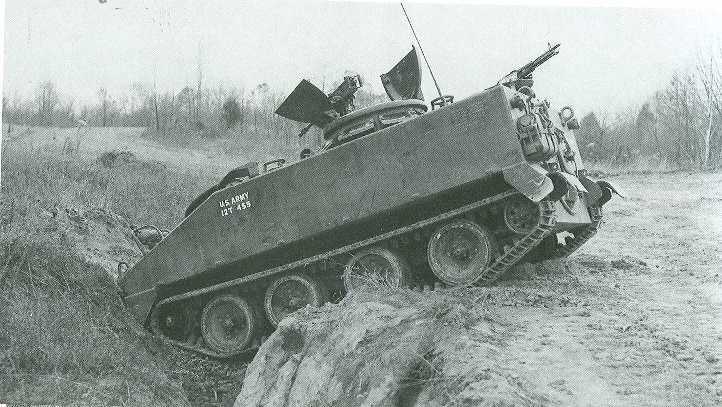
Stryker truck stuck...and struggling to negotiate small ruts
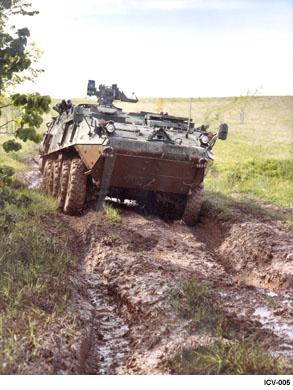
The Path to Success for the Future in Land Warfare
* RPG pre-det bird cage all around but not so wide so Super Gavin can still roll-on/off C-130s
* High Hard Steel belts on sides, front, rear to increase roadside bomb and bullet protection to beyond 14.5mm HMG protection
* Underbelly armor to defeat land mines
* Extra spall liner inside
* TAGS see-thru gunshields to protect and see enemy first to shoot & kill him
* Ability to stow troop gear, sandbags on outside beneath hull and bird cage to increase ballistic protection levels
* Rolls on tracks that are cross-country mobile and do not puncture and burn like Stryker truck tires
The point of all of this is that an infantry carrier's protected volume requires innovative armor layering beyond just making the hull thicker and heavier or thicker and the same weight using exotic material ("plastic tanks" of the Future Combat System). Even twice as thick is still not as good as 10x as thick in a more compact tank.
The compact M8 Buford AGS light tank can however, free up enough space by using compact hybrid diesel-electric drive (HED) to carry a 4-man scout team to bolster force synergism with M113 Gavin infantry carriers and provide guaranteed local security/recon for themselves. Other light tanks could have 20-40mm autocannon turrets to be "female" Tracer tanks for the 3D force's "male" Buford 105-120mm gun tanks so the 3D force has the exact same combined-arms synergism of the Abrams/Bradley/Gavin team in the 2D force. These extra 4 Soldiers also mean the tank can be operated around-the-clock if they are trained properly to be commanders, gunners and drivers in addition to being dismount scouts. HED in an infantry carrier means even more Soldiers and supplies and armor layers can be carried inside or outside with greater power for mobility. HED also means silent stealth operation and more battery power to operate long-range image intensifier and thermal sensors at night with engines turned off. HED also means back-up power means in case the front drive sprockets are taken out by a land mine since the electrical power can be transferred without heavy metal drive shafts like on the M59 to a second set of tracks that otherwise are in unison with the front sprocket's tracks. Think of a helicopter-transportable Bv206S Ridgway except with its 4 sets of tracks in just one hull not two hull bodies.
The U.S. Army's Future Depends on tracks not wheeled trucks
Non-Linear Battlefields Require FULL armor protection: tracks are 28% more capable of armor protection--and can go cross-country to avoid ambushes in the first place!
SO WHY ARE WE TRAVELING IN VULNERABLE TRUCKS DOWN ROADS INTO PREDICTABLE AMBUSHES?
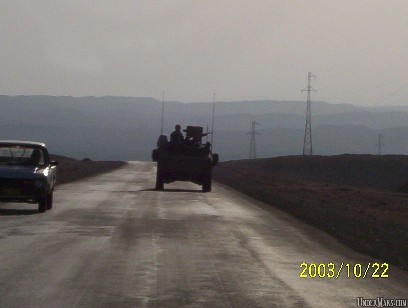
Can a Stryker/Humvee wheeled truck go through this kind of mud? Hardly. Only Light tracks like the M113 Gavin can!
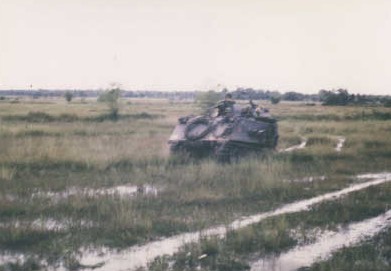
Falklands War decision: what would U.S. light infantry do?
Brigadier Julian Thompson in his book, No Picnic on page 11 writes:
"I was decided at an early stage in planning to take the minimum number of wheeled vehicles. The going anywhere in the Falklands away from the settlements was so bad that even a lightly loaded Landrover would be lucky to cover four miles an hour. Vehicles loaded with ammunition and stores would be lucky to move at all. The Brigade did have seventy-six of its BV202 oversnow vehicles in England, the remainder being stockpiled in Norway. Although designed to operate over snow there was a good chance that these vehicles with a ground pressure of only 1 1/2 lbs per square inch, about that of a man on skis, would be able to motor across the peat bog. Events were to prove they could."
How many tracked vehicles do U.S. Army light infantry units have?
ZERO.
Unfortunately, the Army's light units with Delta Anti-Tank (AT) Companies use unarmored, High-Mobility, Multi-purpose Wheeled Vehicles (HMMWV or "Humvees"); mere 4x4 trucks without the cross-country mobility, armor protection or space in the back to carry A, B, C Company infantry Soldiers as required to conduct real world missions such as rapidly fanning out from Drop Zones (DZs) or Landing Zones (LZs) into enemy territory to engage fleeting asymmetrical enemies as depicted in the scenario above. The Humvee, as a wheeled sport utility not combat vehicle, simply cannot go cross-country at will through vegetation, soft soils, or up and down slopes. It is often road or trail bound, and thus easily ambushed and destroyed at Combat Training Centers (CTCs) like the Joint Readiness Training Center (JRTC) and sadly in combat in Afghanistan and Iraq. Wheeled vehicle are 28% less capable of armor protection than more weight/space efficient tracks. When you slap all kinds of armor on it, Humvee mobility degrades further and mechanically it starts breaking down. This is vividly described by Brigadier General Dan Bolger in The Battle for Hunger Hill and more ominously by real casualty reports in recent combat actions in Iraq, not to mention the 1993 Somalia raid described in the book and film; "Blackhawk Down!" The HMMWV is a truck, and not a combat vehicle, with air-filled rubber tires easily punctured and set on fire in a firefight resulting in a mobility kill, and potentially a total kill if the men inside do not get out of the vehicle. Delta Companies, as the main organic anti-tank and mobile security force for foot-mobile light infantry, must not be easily attrited or else the entire main body will be placed in a position of having to fight for its life. The Airborne must land and take the fight aggressively to the enemy without having a "glass jaw;" it must be able to fire and maneuver at will anywhere on the terrain and shrug off enemy fires encountered to attain important objectives - not be damaged and immobilized.
The Army wheeled narcissist lie exposed: Video Proof that steel tracks can go 60+ mph on paved roads
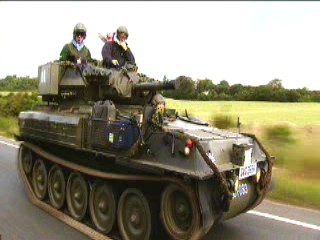
This should end the "Stryker and Humvee 60 mph on roads" non-sense forever. Take the governors off our tracks and they can go as fast as you want them. There is NO reason to have or use rubber-tired trucks on thr non-linear battlefields of today...they need to go the way of the horse cavalry.
Edited Clip
www.combatreform.org/steeltrackscango60mphonpavedroads.wmv
Full Clip with an excellent short History of Tanks
www.pioneertv.com/video/tanks900.wmv
Recent Productions
http://72.14.207.104/search?q=cache:FFlc_wMMrHAJ:www.pioneertv.com/recent.asp+tycoon+toys+national+geographic&hl=en&ie=UTF-8
Tycoon Toys
(2 x 60' for National Geographic Channel/Freemantle International Distribution) are what the super-rich choose to spend their hard-won zillions on. We meet the few individuals who have a particular penchant for owning, driving and firing huge pieces of ex-military hardware, from field guns to tanks to fighter jets. Tycoon Toys goes on a journey to watch them at play. 2004 - Distributed by: Freemantle International Distribution
Many Army officials simply do not understand the non-linear battlefield and how wheeled trucks cannot be made to withstand high explosives attacks before being outclassed by bigger and bigger bombs. The RMA pundits proclaim mental gadgets will enable them to "avoid the hit" yet want these gadgets placed in wheeled trucks that cannot leave paved roads predictable to the enemy where they will be hit and they will be destroyed, and our men not killed, maimed. Trying to speed and miss a rebel with his finger on the button to detonate a bomb is not working, either, look at the Iraqi dead just from accidents, our 4 minute mini-movie
www.combatreform.org/INVINCIBLEforinternetcaptioned.wmv
shows how the Army's light infantry battalions do not have a single tracked armored vehicle but this could be easily fixed by re-equipping their Delta Weapons companies with plentiful M113 Gavins now in storage which will enable them to give Alpha, Bravo and Charlie companies armored transport as required. These units should have Combat Engineers organic to them to overcome land mines and obstacles, redesignated as "Engineer Cavalry" (ECAV) troops. Engineers will with demolitions training keep infantry narcissists "real" about what their bravado can and cannot do on the HE dominated NLB. Other M113 Gavins converted from storage can carry supplies on PLS flat racks and in ISO containers to protect transportation units and enable them to get off paved roads where enemy bombs and RPG gunmen lurk. The ISO containers can be dug-in to protect our Soldiers and others used as barriers filled with dirt to create bomb-proof check points instead of sitting idle when emptied.
American Iraq War Casualties Report v1.0
www.oocities.org/militaryincompetence/americaniraqwarcasualties.htm
BOTTOM LINE:
Of our 1, 331 (December 31st) dead in Iraq at least 1,000 could have been saved if we had been better physically equipped just on the ground...
Why the M113 Gavin light tracked AFV is the positive future of the U.S. Army
Since the dominant killer of American troops since Vietnam has not been the bullet but the bomb---high explosives dominate the non-linear battlefield (NLB) via artillery, mortars, RPGs, roadside bombs (land mines) etc---this is not saying that bullets do not need to be armored against as well--the old style PASGT soft flak jackets misconstrued that there was no need for hard plates to stop bullets---but that slapping one layer armor layer onto a previously unarmored truck just to stop small arms fire is not enough. The failure of so-called "up-armored Humvee" trucks in Iraq is a sad testimony to what many people warned current Army officials not to do. Even building an armored hull and slapping it onto wheels like the Canadian-made Stryker truck is not enough because the tires are easily shredded and set on fire and the whole conglomeration ends up being 28% heavier than a more compact tracked armored fighting vehicle (TAFV). We cannot afford to sacrifice 28% of every possible armor protection by rubber tired wheels and we certainly cannot forgo x-country mobility to avoid road ambushes in the first place and stay mobile on a planet earth full of mud that is rapidly urbanizing into areas that when war strikes will be full of rubble, debris, broken glass, twisted metal and barricade cars that an armored hull slapped upon rubber tires will not be able to cross. Some like Major Greg Pickell USAR may say why not start with a heavy 40-ton M1 Abrams tank chassis (30 tons of the M1's weight is its turret) and make tank infantry carriers like the Israeli Defense Force (IDF) does on a small-scale so we have even more armor protection to start with?
The answer is YES, we should have SOME M1 derived heavy armored personnel carriers for the 2D maneuver forces that operate in open terrain providing the entire M1 fleet get fuel miserly diesel piston engines to get a decent 1 mpg fuel rate instead of the current 7 gallons per mile abomination turbine engines they use, which also need lots of collant air which makes their rear grill areas vulnerable to RPG shots. But NOT for the forces that need to do 3D maneuver by flying in aircraft to get into blocking positions to get the Bin Ladens and Noriegas of this world and to be there first on the scene as a good cavalry via en masse air/sea delivery or bold x-country maneuver through closed terrain to include swimming across lakes and rivers.
FYI: the 173rd Airborne jumped from 15 x C-17s flying together at same time in one formation into Northern Iraq. Why the USAF then trickled C-17s in ones and twos to airland the light, medium and heavy TAFVs is total BS.
Details: www.oocities.org/paratroop2000/paratrooper.htm
THE PIC OF THE SLOW AIRLANDING THAT FOLLOWED
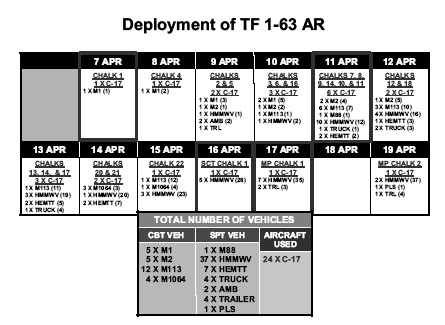
If we had a 173rd Airborne Brigade with M113 Gavins and M8 Buford/Thunderbolts they could have parachute dropped ON DAY ONE with 24 x C-17s:
72 Gavins or 48 Bufords or combinations.
Airlanding:
120 Gavins or 96 Buford/Thunderbolts.
And even better---the light TAFVs would have been able to rapidly move south where the medium 33-ton M2 Bradleys and 70-ton M1 Abrams could not.
Quote:
"The route south from Taqtaq was not suitable for armored vehicle traffic, unfortunately. Several of the bridges along the route were incapable of supporting Abrams tanks. Additionally, road conditions deteriorated significantly south of Taqtaq. Unimproved mountain roads and narrow village streets greatly restricted armored vehicle mobility. This route was, however, suitable for lighter vehicles and was used by the 2d Battalion, 503d Infantry (2-503d) during their attack on Kirkuk."
Source U.S. Army ARMOR magazine article:
www.knox.army.mil/center/ocoa/ArmorMag/so03/5maddox03c.pdf
THIS IS ONE OF THE REASONS WHY SADDAM & COMPANY ESCAPED!
The IDF with a limited nation-state defense mission does not have to rapidly deploy globally and fight in all climes and places as the U.S. Army has to. Another aspect is that we can neither afford the entire Army to operate inside heavy TAFVs nor the negative tactical consequences of having to refuel them with a constant stream of dangerously vulnerable fuel tankers. But WE CAN GET EVERYONE IN THE ARMY OUT OF TRUCKS AND INTO AFFORDABLE LIGHT TAFVs that will protect them from bombs and bullets if upgraded because they have an armored hull that can have multiple armor layers fitted.
If Army leaders would grow a pair of testicles (selfless moral courage) they could stop accepting pacifist politician's congressional district "pork" money to build more and more civilian static buildings on military bases which bogs the entire Army down on lawn and building care. Real, enlightened warfighting leaders would demand the entire force be mounted in TAFVs and in ISO sea/air/land containers and have units regularly shipped to uninhabited areas where they can train without hindrance from eco-nazis worried about absurd species extinction fears and garrison phony milicrats keeping posts looking pretty to win awards and please local civilians that we are not a bunch of cut-throat killers---when we need to be killers. As long as we are also mature adults who realize war is a necessary evil not a prop for a weak ego, as long as our new culture enables every Soldier at every level to think and have a moral compass the powers to kill inherent in a TAFV force will be used wisely.
What we can do, we must do. For example, the marines were several days late reaching eastern Baghdad while the Army's 3rd Infantry Division waited in Western Baghdad allowing Saddam and his cronies to leave and start a guerrilla war all because they were 75% in vulnerable trucks and could not bypass mere Fedayeen rear guards; having to clear towns on foot. As another cautionary example, up in northern Iraq, the Army 173rd Airborne Brigade was also remiss for flying in M113 Gavins and M2 Bradley and M1 Abrams TAFVs slowly airlanding them one planeload at a time when they should have owned their own light TAFVs and parachute dropped them when they jumped so they could have fanned out and blocked Saddam's escape routes from Baghdad. We did this in Panama and got Noriega; we didn't in Afghanistan and Iraq and both Bin Laden and Saddam got away.
Enter the Gavin...
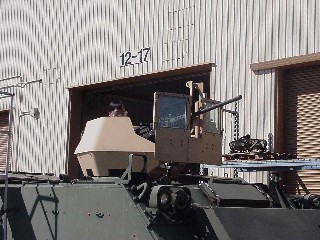
The Army led by General James Gavin created the Airborne Armored Multi-Purpose Vehicle Family of TAFVs to roam over devastated nuclear battlefields which we know today as the M113 Gavin. This parachute airdroppable, amphibious TAFV named by troops who love it after its creator, offers still the best mobility against earth elements and baseline protection against bullets and bombs, and is in huge numbers in Army service. The first step to adapt to today's NLB would be to take every single Gavin we have out of storage and supply them to the Light Infantry's Delta Weapons Companies to as needed give Alpha, Bravo and Charlie Companies needed armored mobility so they can encircle kill and capture fleeing enemy sub-national group terrorists and to Army supply units so they can withstand enemy attacks to keep ourselves sustained in places like contested Iraq. These units would have combat engineers organic and be renamed Delta "ECAV" troops. Resupply of fuel would be by towed trailers and ammunition from inside the Gavin's armored hull by muscle power quickly through open hatches. Spaced armor and gunshields, weapons hatches etc. can be fitted to M113 Gavins with no ill mobility effects if they are up-engined A3 variants; those that are A2 variants can be upgraded affordably with bigger engines and external fuel tanks in a matter of days to transform the entire U.S. Army within 1 year to NLB dominance. That is PHASE I.
Gavin Advanced Infantry Fighting Vehicle
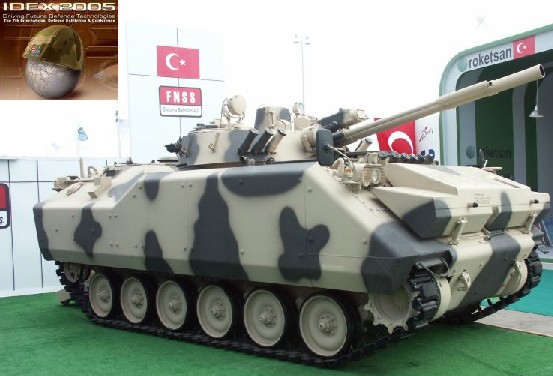
The PHASE II "M113A4" Gavin would be new production and old vehicles modified to have an underbody "V" hull shape and hinging side skirts to withstand the threats from side and below from enemy bombs. The Army should be already diligently blowing up its vehicles and testing new shapes to defeat the threat from mines. Multiple armor layers to pre-detonate RPGs and defeat ATGMS with gunshields and the previously described weapons hatches would be standard so troops could fight mounted either on top or buttoned up. Designated Gavins would have a 1-man 20-40mm autocannon turret to dominate the battlefield with lots of suppressive and penetrative fire through buildings and to destroy suicide vehicles as the 3rd Infantry Division's "Thunder Run" to take Baghdad lessons learned indicate. The front of the vehicle would be slanted for a greater sloping armor effect, have infared defeating ghillie type coverings and hybrid-electric drive and band tracks fitted for stealth and 60+ mph road speeds without losing x-country mobility. Steel tracks with rubber pads will always be an option if being civilian populace gentle and quiet are not needed. Two FLEX-CELL fuel bladders strapped to the outside ("Camel-Baks for tanks") would double range from 600 miles to 1200 miles without resupply. Ammunition in trailers would be towed to keep the Gavin's machine guns and autocannons fed all the way from assembly area to the taking of the enemy's nation-state governmental centers of gravity. Some Gavins would be fitted with ARIS SPA waterjets and nose section to swim from ship-to-shore so Army sealift ships could rapidly unload without needing a port, which even the high-speed catamarans are dependant on. These "AmphiGavins" would also be light enough to fly by heavy lift helicopters from ships-to-shore to effect 3D dominant maneuver.
Gavin Armored Resupply Vehicle
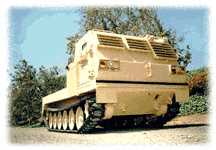
The Army resupplies its heavy units with palletized loading system (PLS) flat racks that can be picked up and dumped off by special but vulnerable wheeled trucks. A M113 Gavin can have its hull cut down to operate a PLS flat rack system so resupply units can be armored to withstand and fight back with gunshielded machine guns to avoid becoming Jessica Lynch convoys. Called the XM1108, these Armored Resupply Gavins could pick up and drop off fuel bladders and ammunition pallets protected under covered blankets and not have themselves and their cargos at risk of enemy destruction as the 3rd ID's resupply columns faced during the nation-state war phase of the second Iraq war. With hybrid-electric drive, Gavins would have 600 mile range and would have another 600 miles of range simply by the XM1108 dropping off another pair of FLEX-CELLs. For the 2D force's medium Bradleys and heavy M1 Abrams, entire PLS flat rack fuel bladders would be dropped off to fill their larger up to 500 gallon fuel tanks.
Gavin Rocket and 155mm Howitzer Fire Support Vehicles
During the 3rd ID's blitzkrieg into Baghdad, self-propelled M109A6 Paladin howitzers fired air burst shells to sweep highway overpasses of enemy gunmen. These types of fires need to be available for the 3D forces of our Army--the Airborne, Air Assault and Light Divisions. Furthermore, even the 120mm main guns on a M1 Abrams or M8 Buford Armored Gun System are sometimes not enough to level a building and 155mm SPHs are needed in a direct fire role. Ther Germans knew this as far back as WWII and the Israeli Defense Force (IDF) has done this many times to win urban fights. The beauty of the Gavin is that its XM1108 with PLS flat racks could be able to pick up a M777 lightweight 155mm gun system and fire it mounted or drop it off and fire it dismounted as the carrier drives back to pick up a flat rack of more ammunition. In fact, the 6-pack 227mm MLRS rocket HIMARS launcher could instead of being wedded to a vulnerable FMTV truck could be placed on a PLS flat rack to achieve the same flexibility and efficiency. The beauty for light units is these 227mm rocket and 155mm howitzer weapons systems can be used separately and flown separately to save weight for CH-47D/F Chinook heavy lift helicopters to fly them for 3D air assault operations.
Gavins are the answer to current and future battlefield needs
Though the M113A3 Gavin is only at 20, 989 pounds empty a "Light" TAFV it can with 500 horsepower HED (which is an amazing 50 horsepower to ton power ratio) be fitted with enough armor and armament to make it essentially a "medium" TAFV to withstand and prevail over today's and tomorrow's enemies. I hesitate to use the term "medium" weight as a virtue since the Stryker's heavier 20-tons of weight is NOT ARMOR PROTECTION but lost in the 28% lost space/weight efficiency of its drive train/suspension and oversized thin hull box to sit on top of it all. You have to pay specific attention to the design and composition of a vehicle's armor and what it can do with active, conscious study/testing not just make broad brush conclusions from the weight scale. Even if the Stryker truck was good (its not) it simply at its current rising cost of $4 million dollars each cannot be afforded in the necessary quantities to transform our entire Army; the M113 Gavins the Army already has can at 1/4 the cost of one Stryker be fitted with capabilities that are simply not possible when you buy a thin box on rubber-tire wheels. The Army's 3D forces will need some M8 Buford light tanks to be the "male" 105-120mm gun tanks to some "female" Tracer AGS variants and Gavin machine gun/autocannon tanks, as the exact enduring war-winning formula discovered in WWI to overcome trench fortifications for mobility becomes necessary again on the urban battlefield populated by gunmen using buildings and rubble for cover. The M8 Buford AGS if fitted with HED and band tracks and with its extra armor to be fitted NASCAR pit stop-style later by its crews can be air assaulted by a modest purchase of Erickson AirCrane S-64 Skycrane helicopters if up-engined with a pair of CH-47F or a trio of CH-53E engines. The "Future Combat System" of vehicles the Army needs but thinks cannot be created for another 10 years at multi-billion dollar expense is already here via upgraded M113 Gavin and M8 Buford TAFVs backed by a modest force of Skycrane helicopters. Buford/Tracer light tanks could be a part of the ECAV troop or a brigade cav troop like the RSTA Squadron as long as its got Gavin TAFVs with LRAS sensors not Humvee trucks so they can FIGHT not just scout & run (WW2 North African M3 White scout car mistake) as the current modularity plans call for.
FEEDBACK!
An IDF veteran writes:
"Results at war are what matter. IDF learned these lessons all the way.
Israel took about 10 years, through the 1950s, getting good at fighting Arab irregulars. But by the early 1960's it got to be pretty tough for the Palis to kill IDF soldiers. When M113 "Zelda" came along, mid-1960s, IDF converted 85% from armored cars. No jeeps including Humvees, ever, are used in high-risk areas.
The early 1960's M113s with internal fuel tank and no extra armor were flammable. Hence "Zippo" for a nickname during the Lebanon fighting. That problem was solved quickly.
Making it hard to kill Soldiers is priority #1. To win, you need to control lethal contact. You need to defeat threats: mines, bombs, RPGs.
We welded 1/4" steel-fronted "air boxes" using 18-guage for the sides. Make 'em 200mm deep and with M113s they're 100% against RPGs. Similar results are available with chain link fence in triple layers hung around the sides. M113 is great against bombs; the wedge works reasonably well against Russian mines.
IDF also converted tanks to APCs. Raphael has a kit for this conversion which provides an American transmission for T54/T55 MBTs. They're called Achzarit, which is slang for "bitch."
Since Iraq still has 1,000 or so T72 MBTs in various conditions, setting up a cut-and-paste operation out at the Baghdad airport was our first recommendation to Bremer's people.
But there was no money in it for anyone important. Ultimately Iraq will have to dominate the 100 or so active death squads, so if the government can't buy themselves M113s -- like the 180-unit buy they wanted out of Switzerland -- converting T72s might end up making sense.
It's the one country that needs more and meaner and heavier bitches.... ;^)
IDF was losing fewer Soldiers per decade, from 1975-2000, against the Palis, than the U.S. has been losing every 3 months in Iraq. Same enemy, more or less. Completely different equipment as noted in this email.
IDF's main transport in Sumaria and Gaza has always been M113. 3,000 of them. Achzarits and the really heavy armored cars have their places, too.
Putting kids in jeeps in high-risk areas is incompetent. It ignores threats. It loses the war.
Jeeps with bullet-proofing are only a minor improvement. Humvee can't carry more than 10,000-pounds; IDF full-up M113 Zeldas weigh 30,000-pounds with the anti-mine wedge.
No military vehicle can patrol urban environments going faster than 8 m.p.h. Or drive roads faster than about 25 m.p.h. Go too fast and you can't see what you're getting into. You get brewed up no matter what you're driving.
In Israel, everybody fights. Every family apart from the hyper-religious.
There, in Israel, it is different from here. Simple example: no jeeps when IDF really goes to war.
When your own personal count gets to 121 contact days against Arab irregulars, tell us again why a 10,000-pound vehicle with no superstructure is better than a 30,000-pound tracker with coax-aimed .50./.30 external guns.
I really can't imagine having to get out of a humvee to return fire. They are not designed in any way for urban combat."
